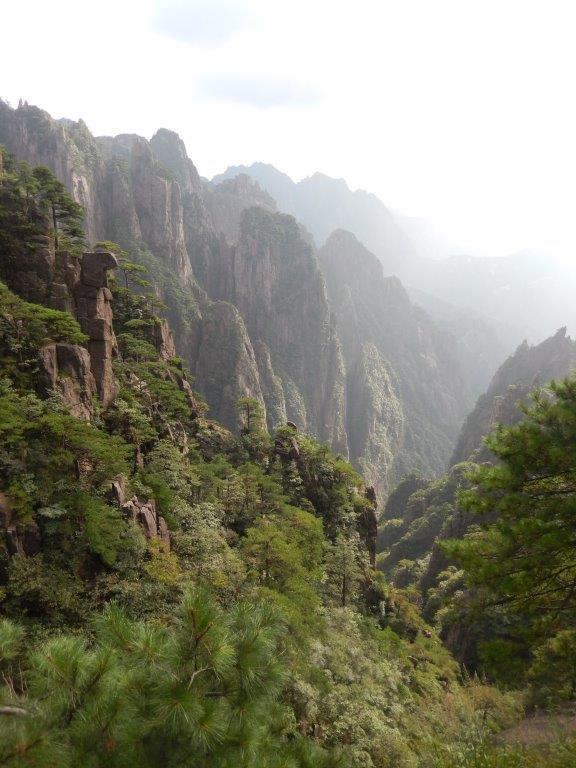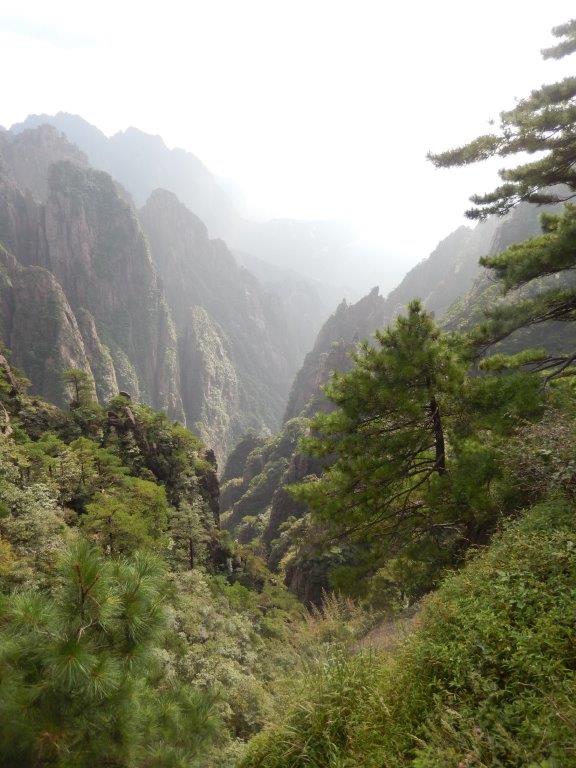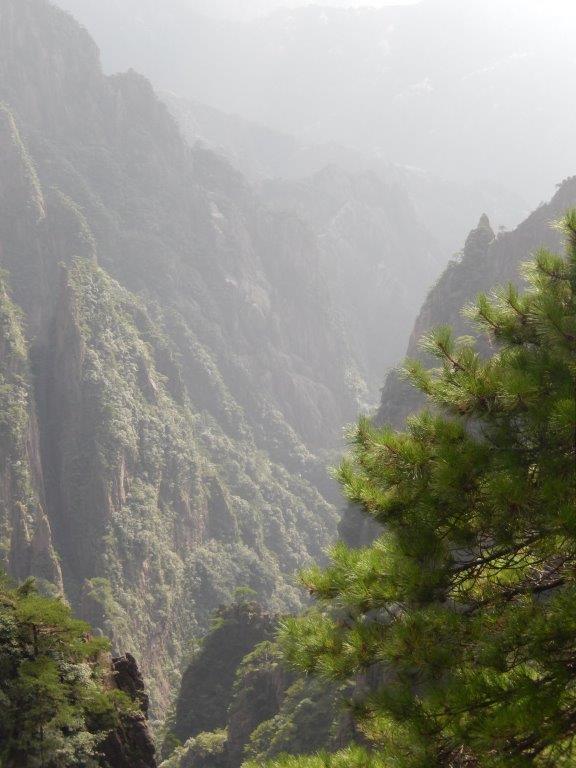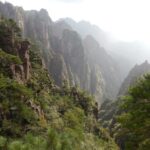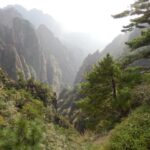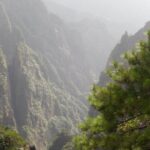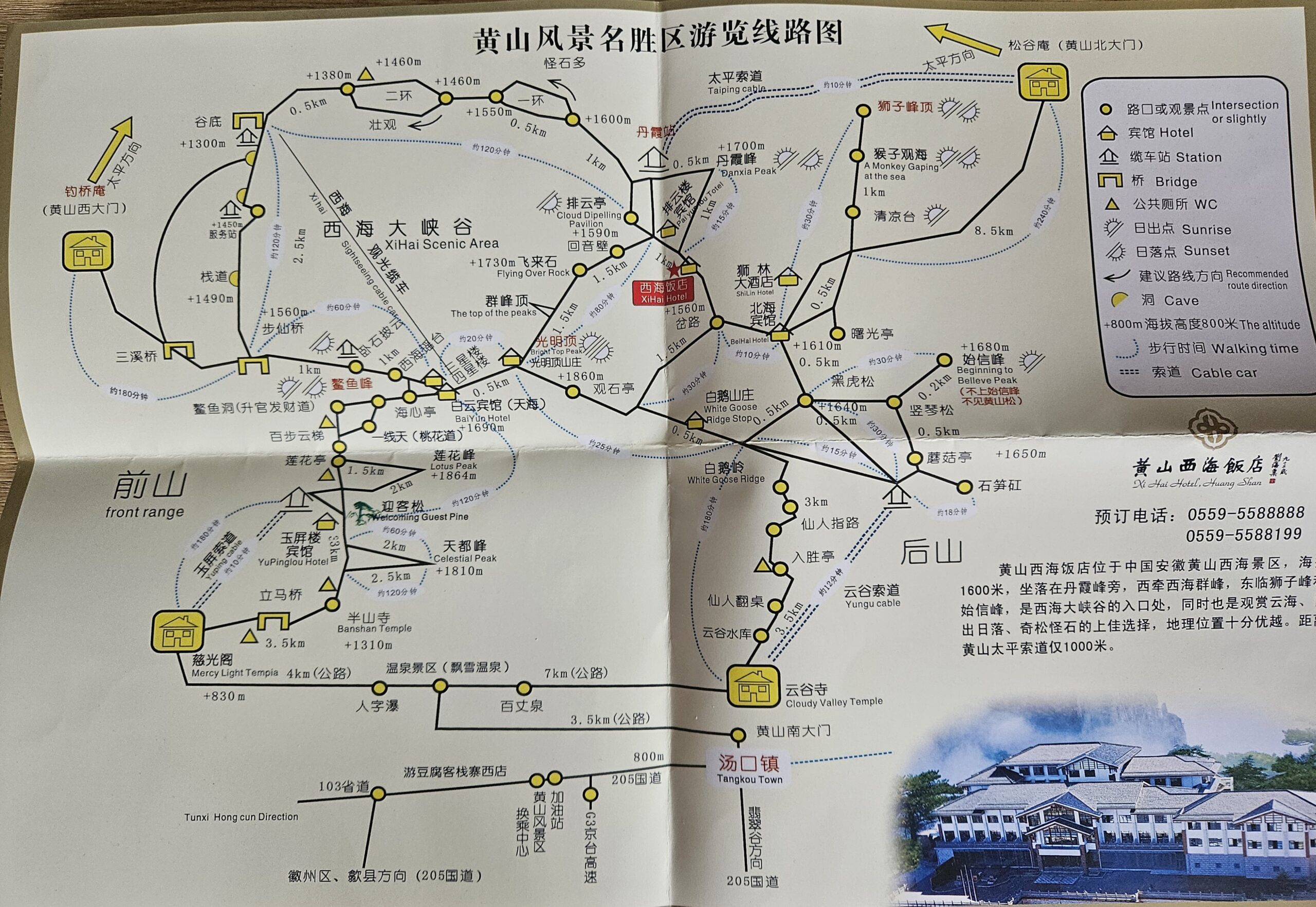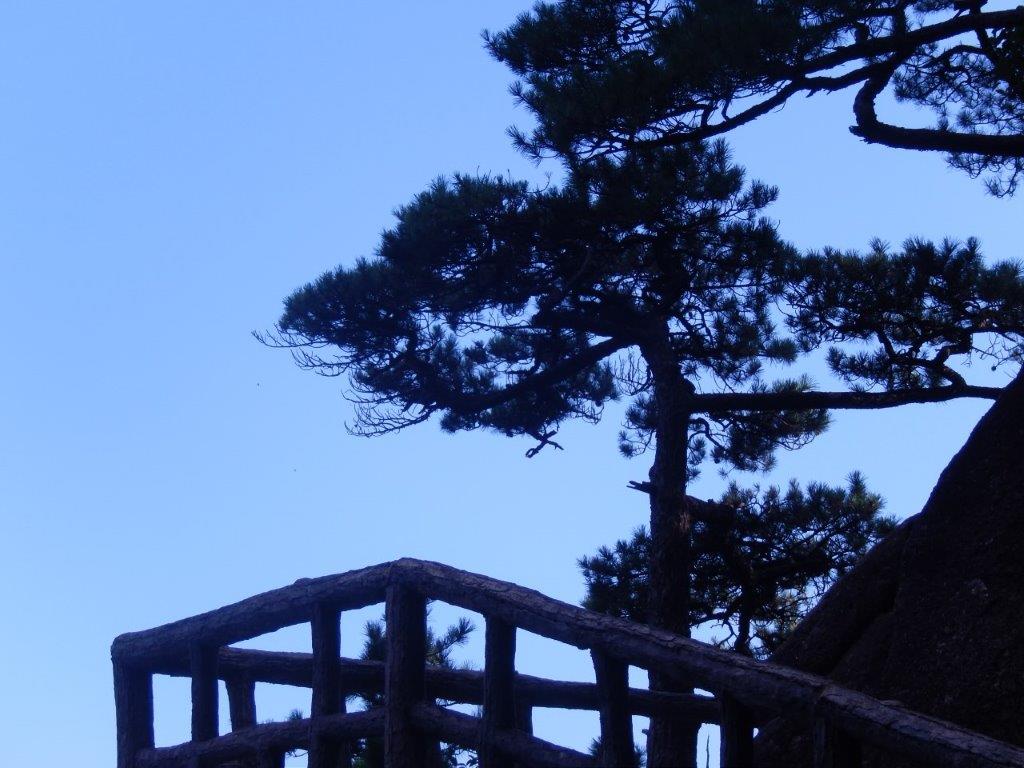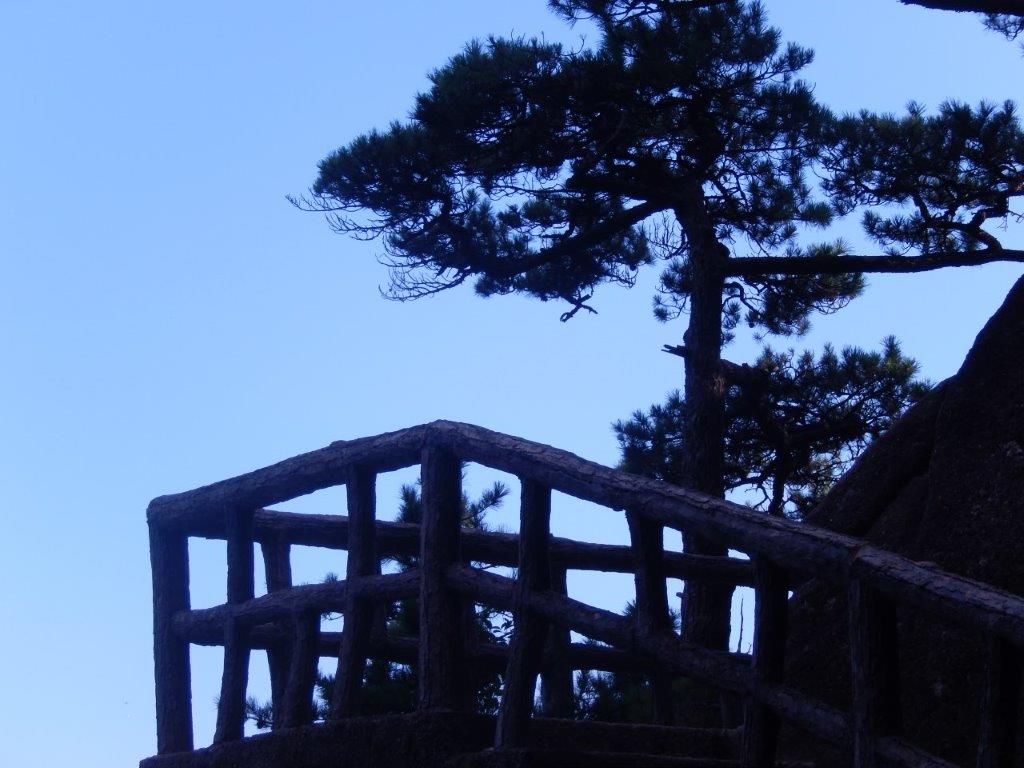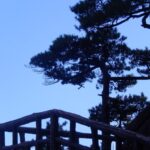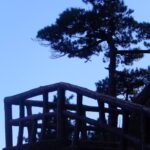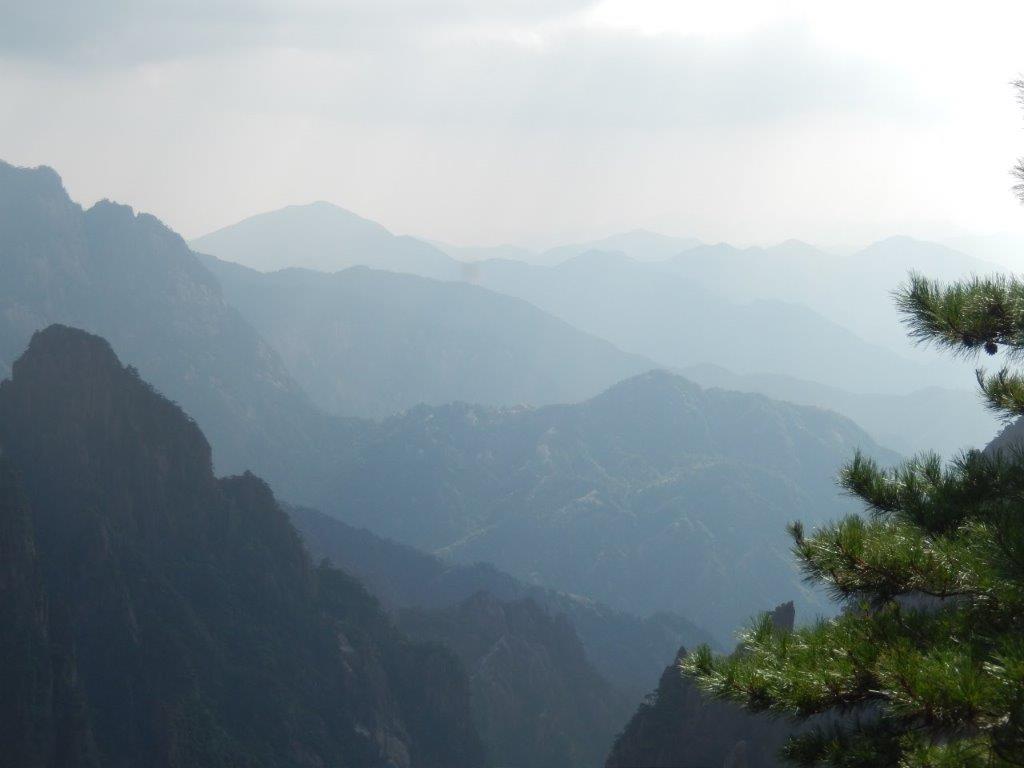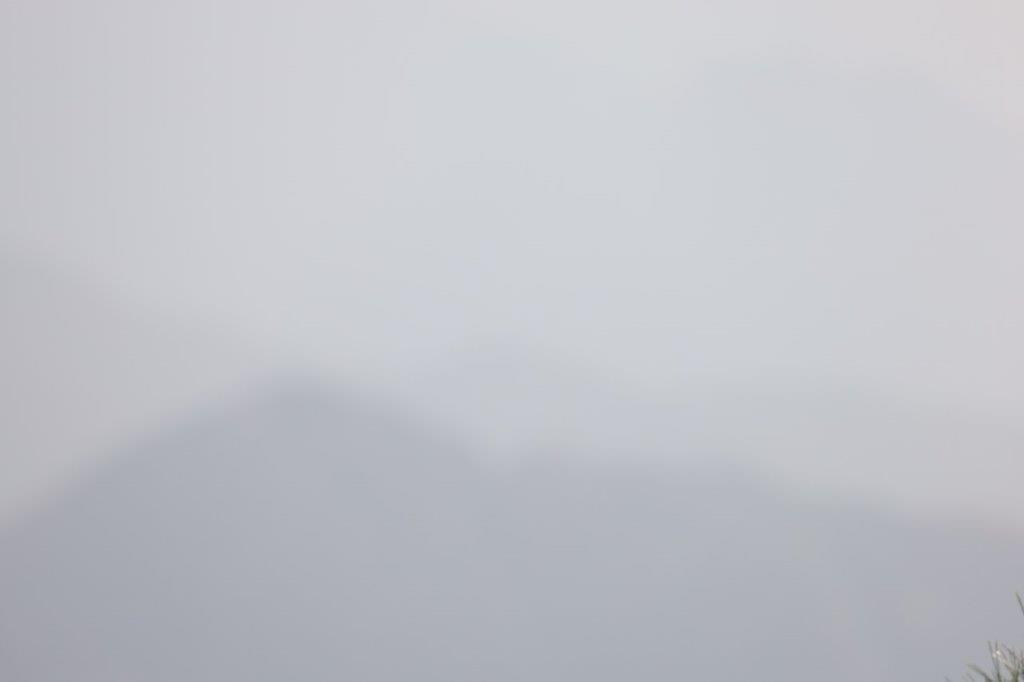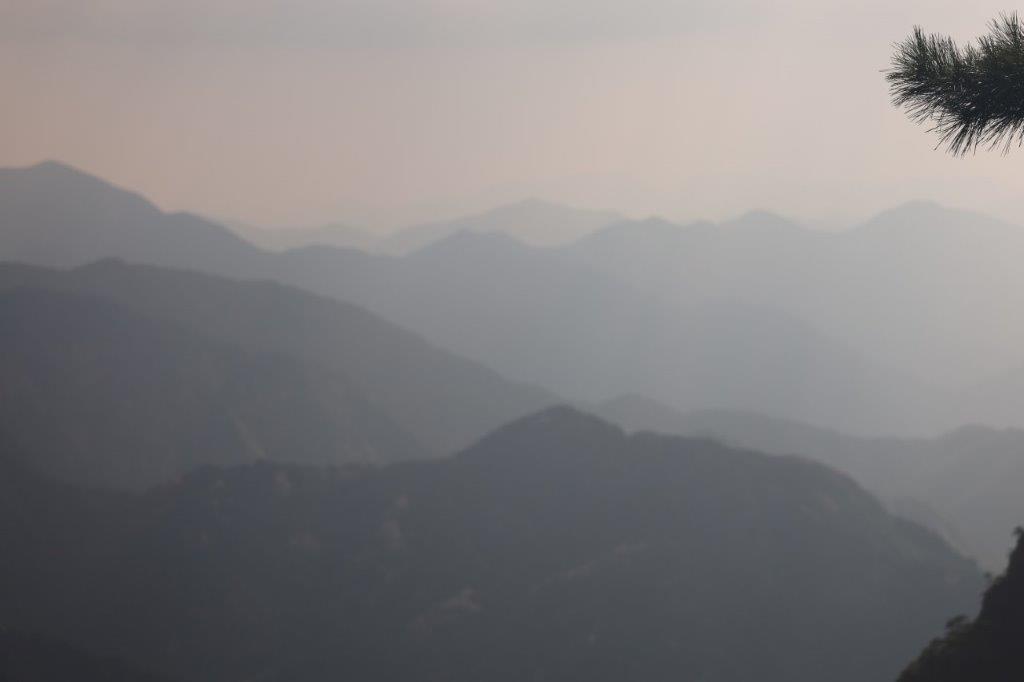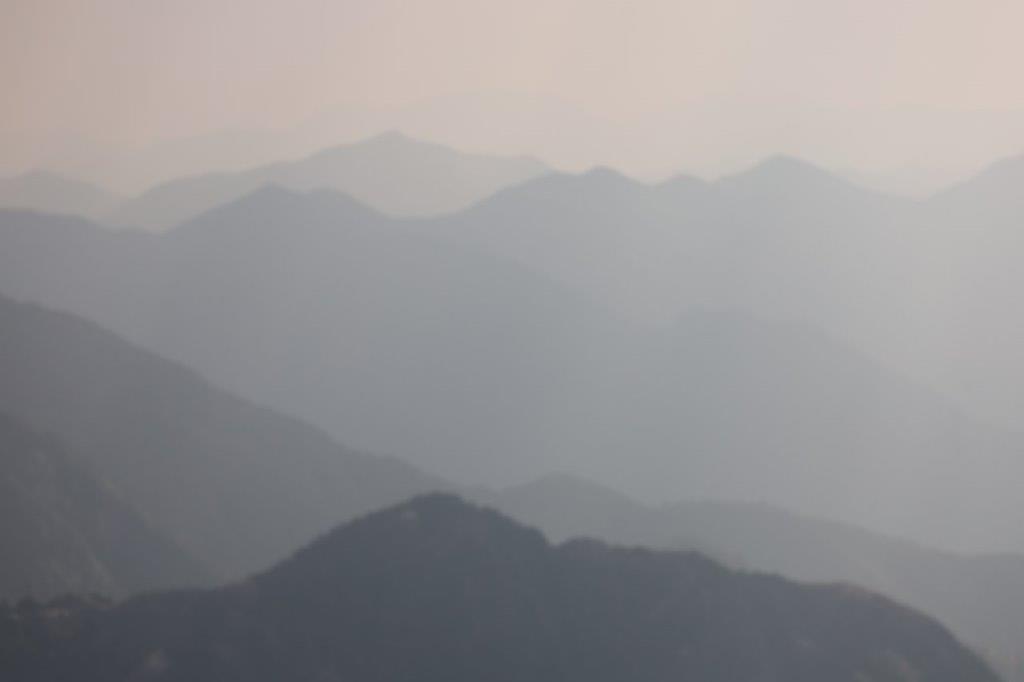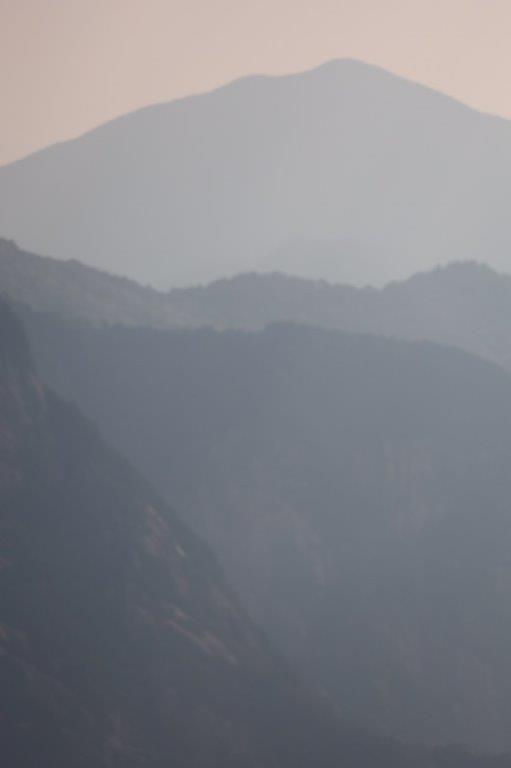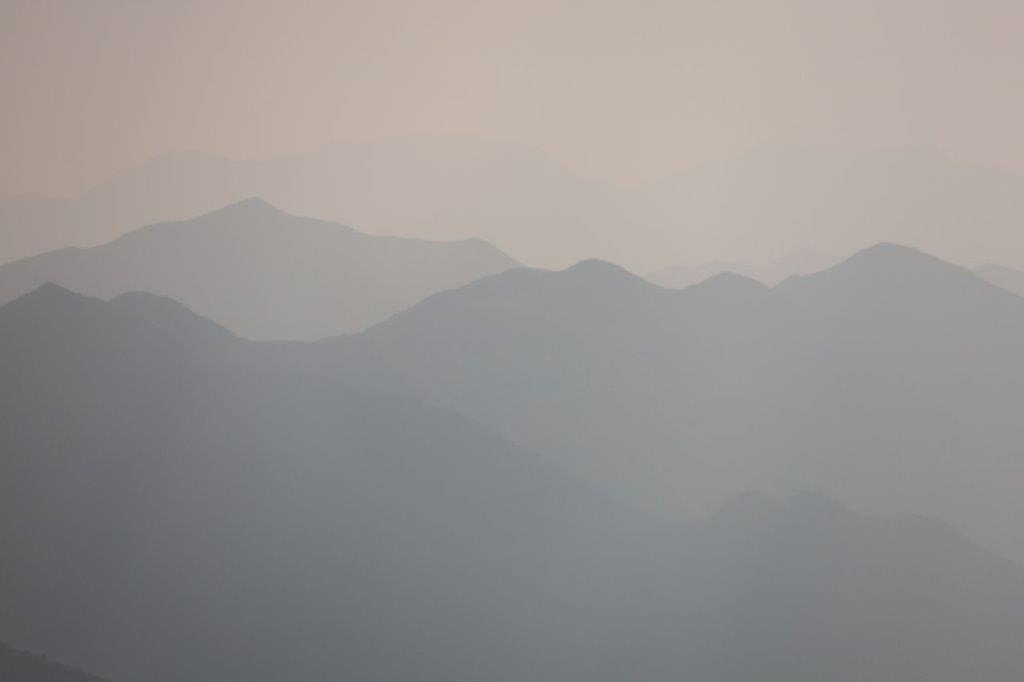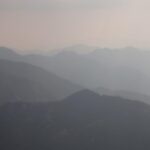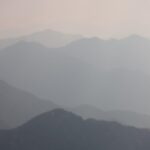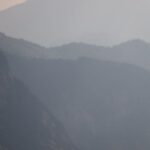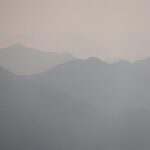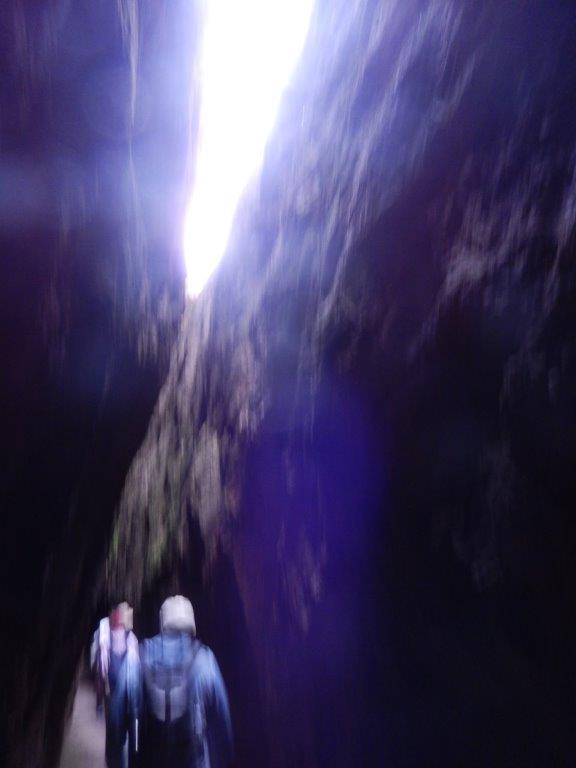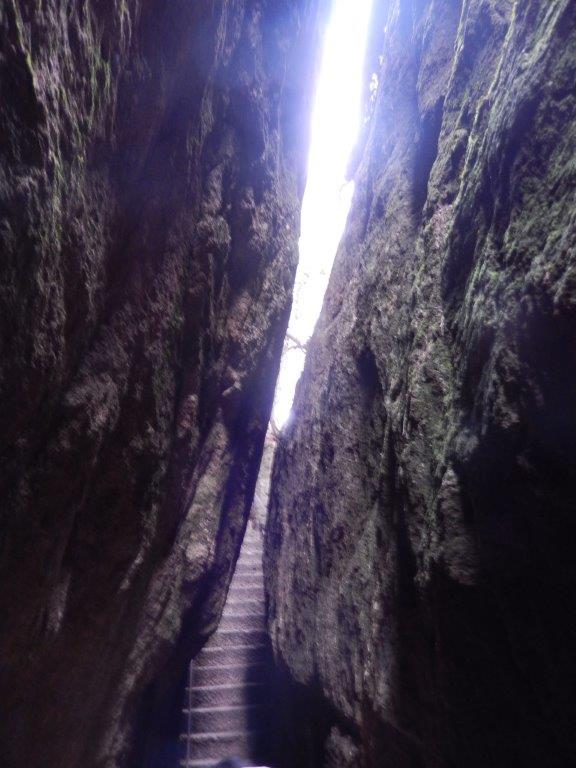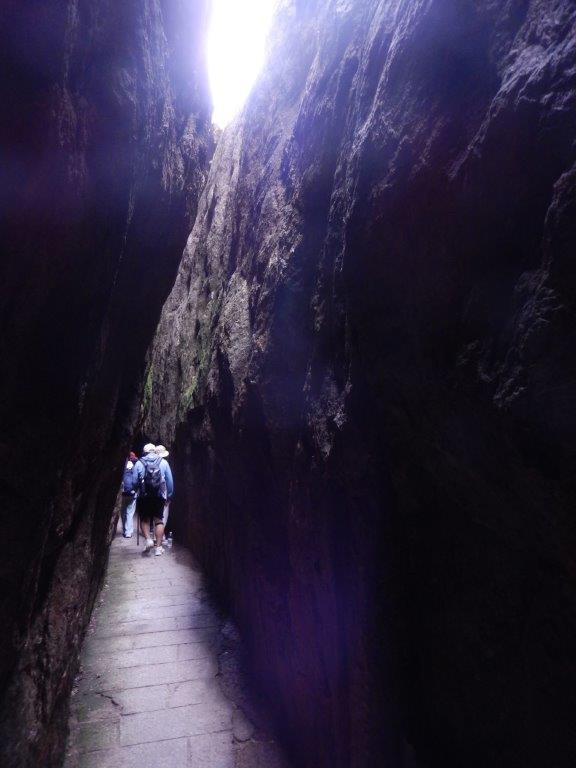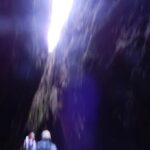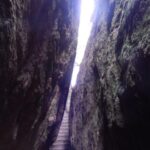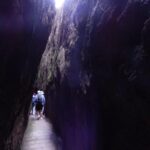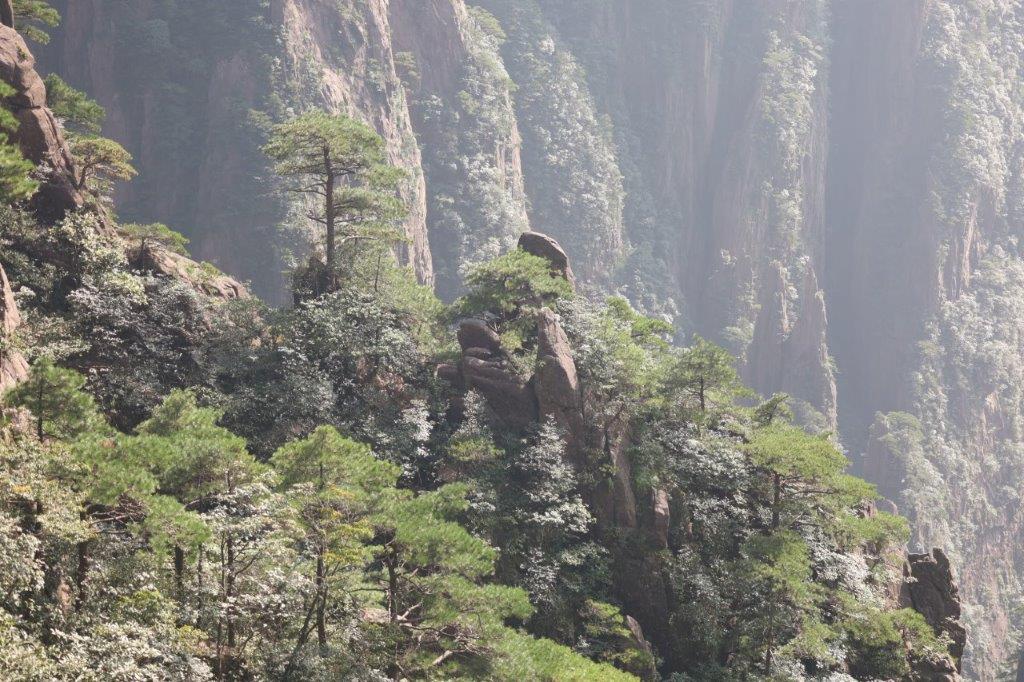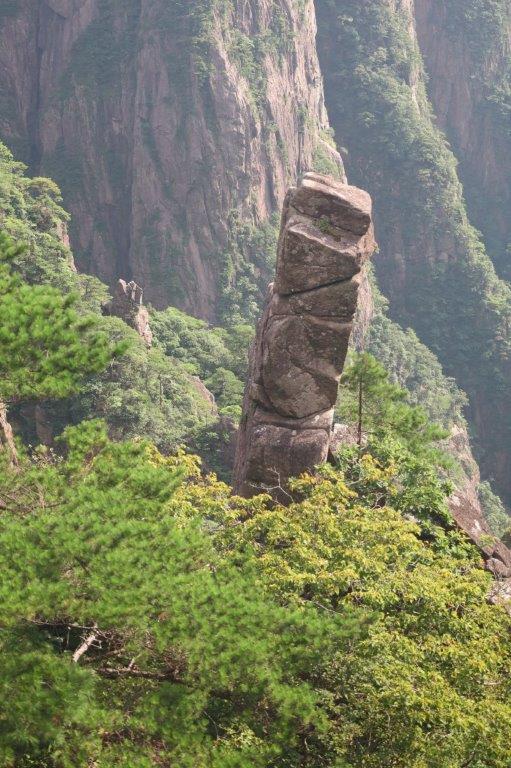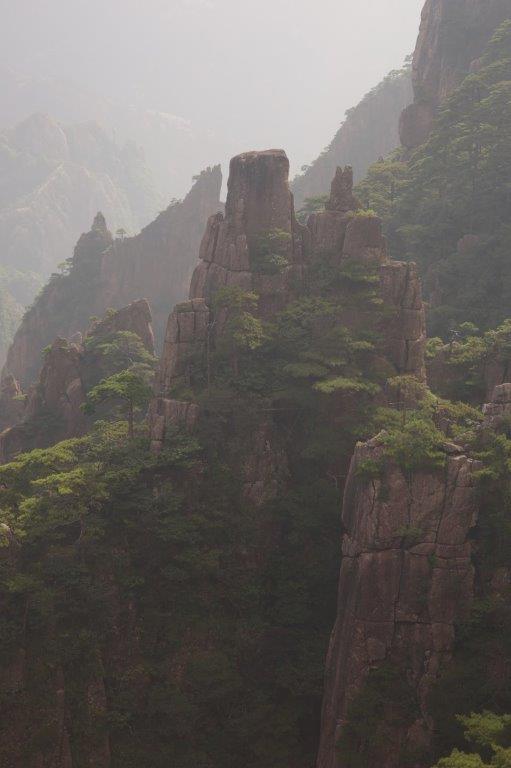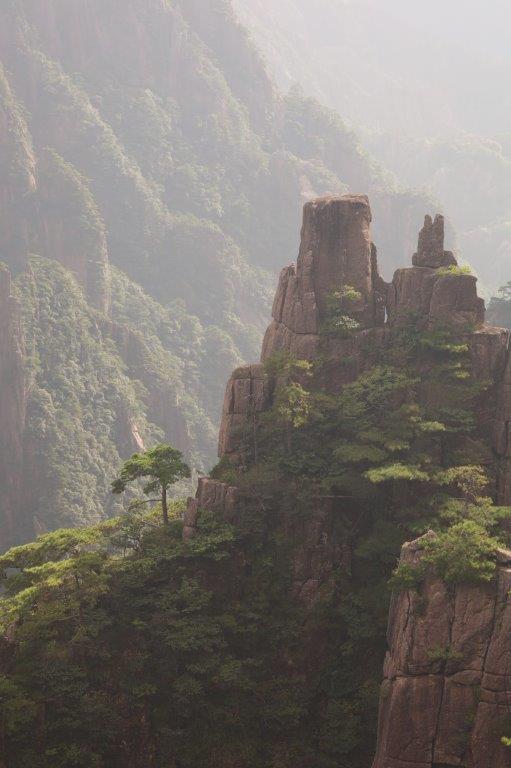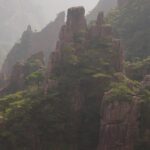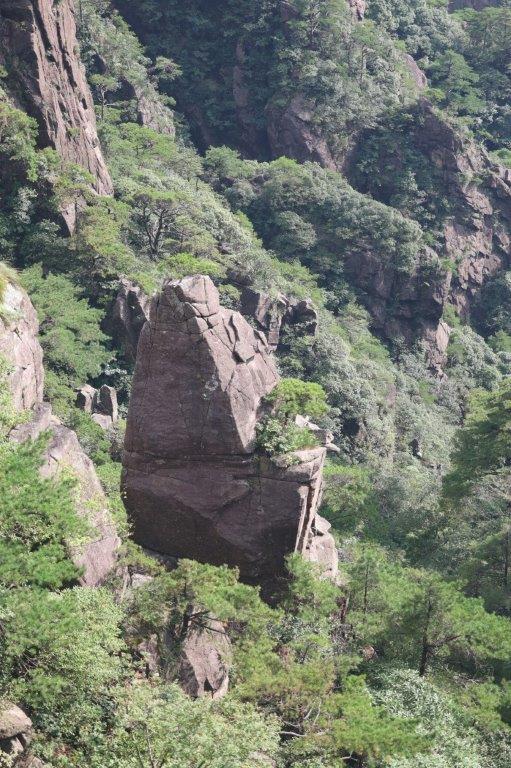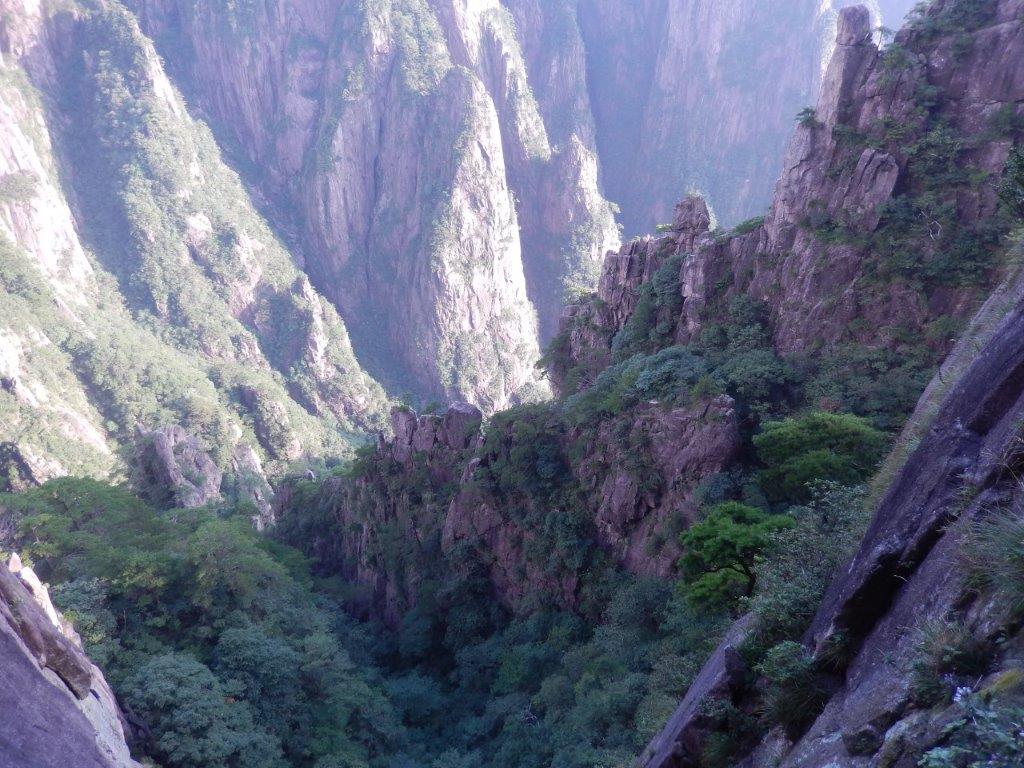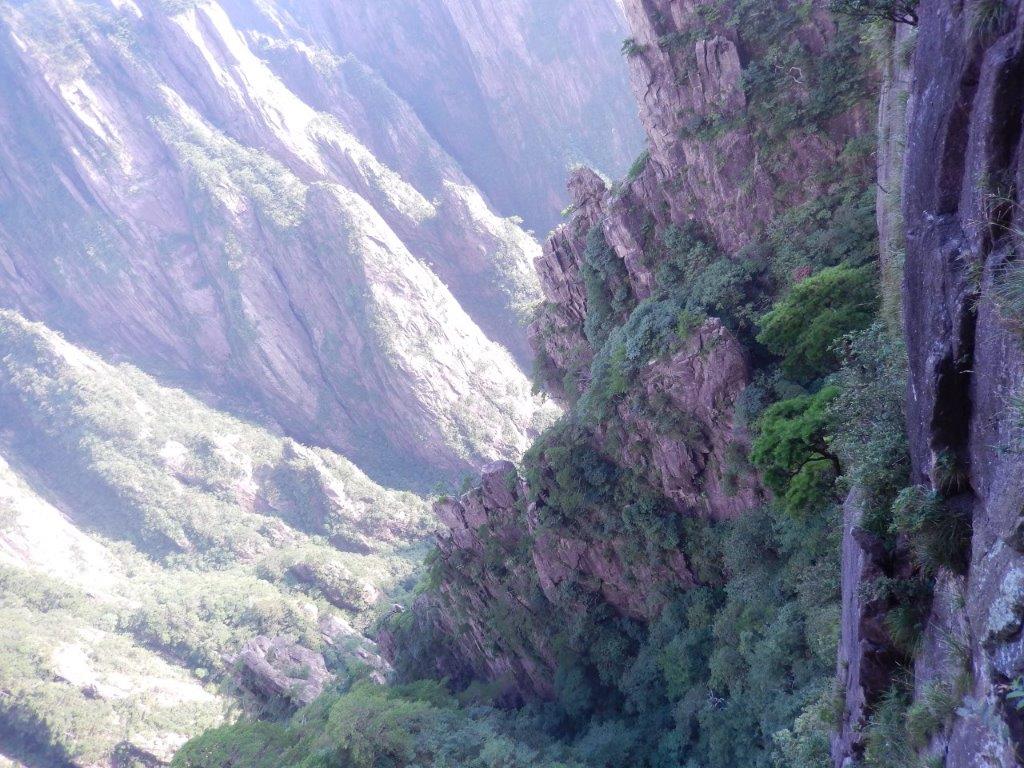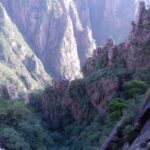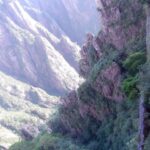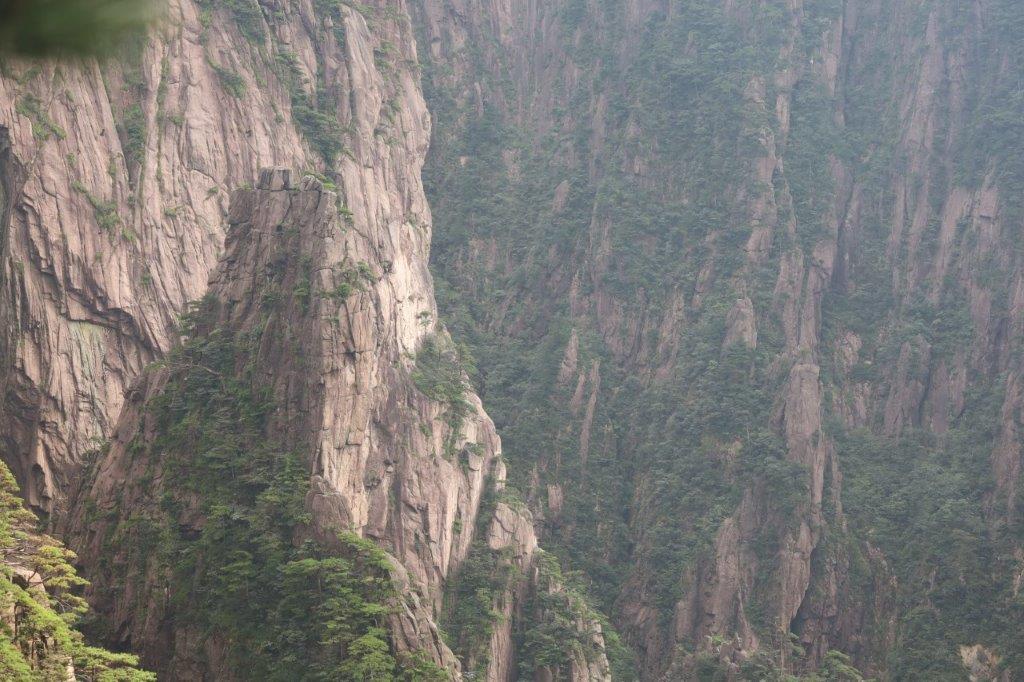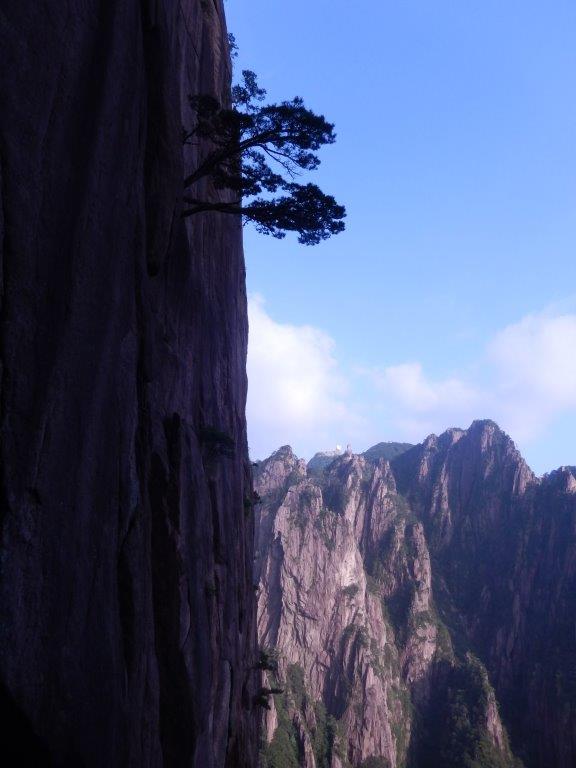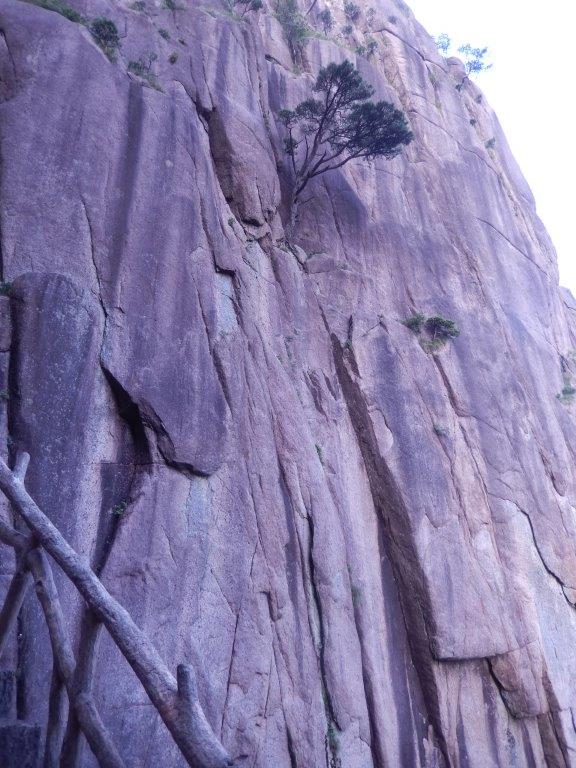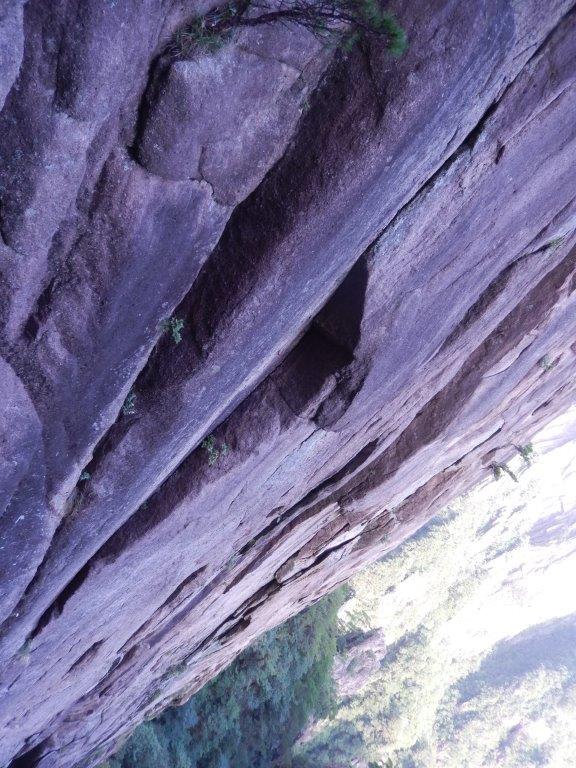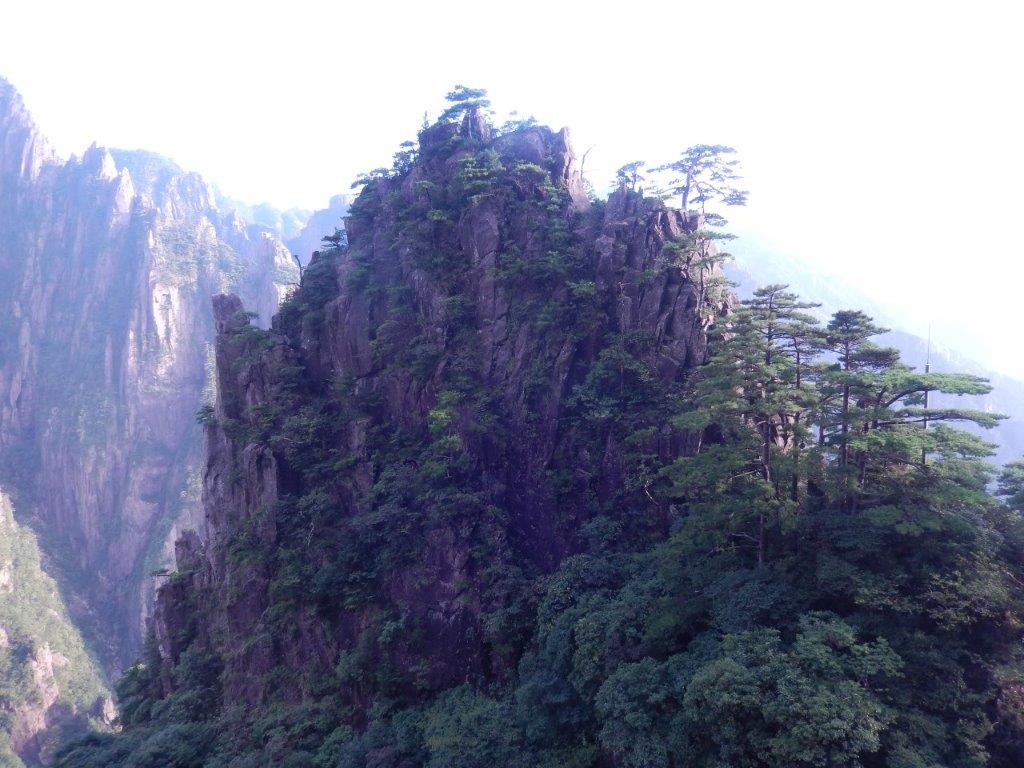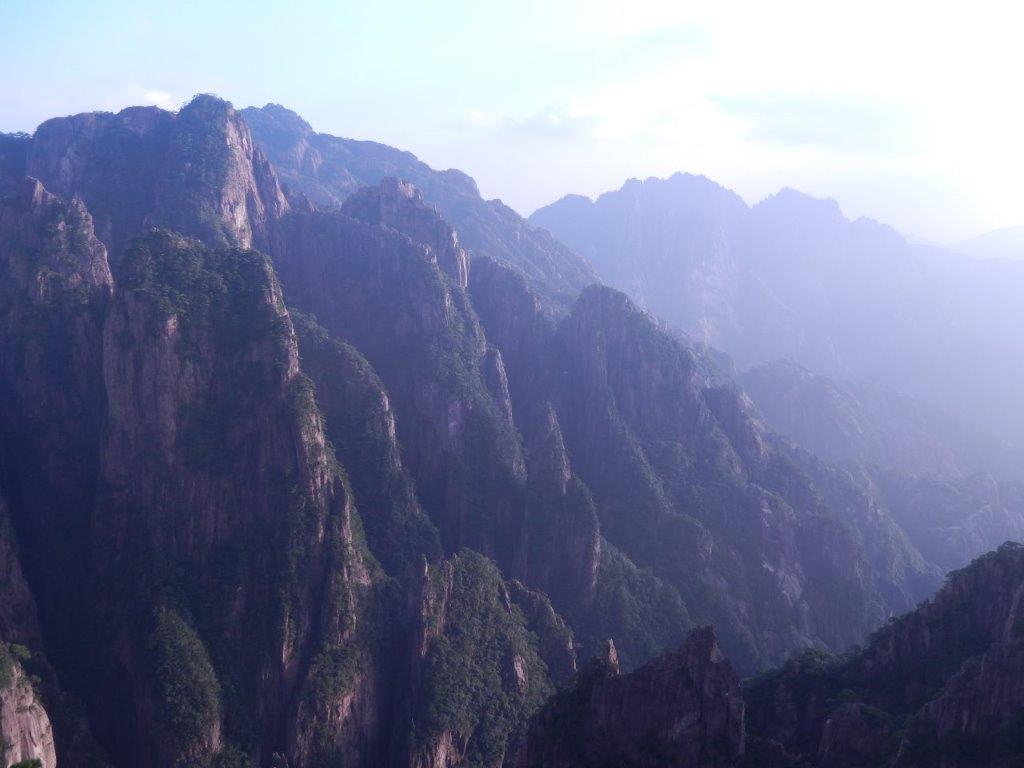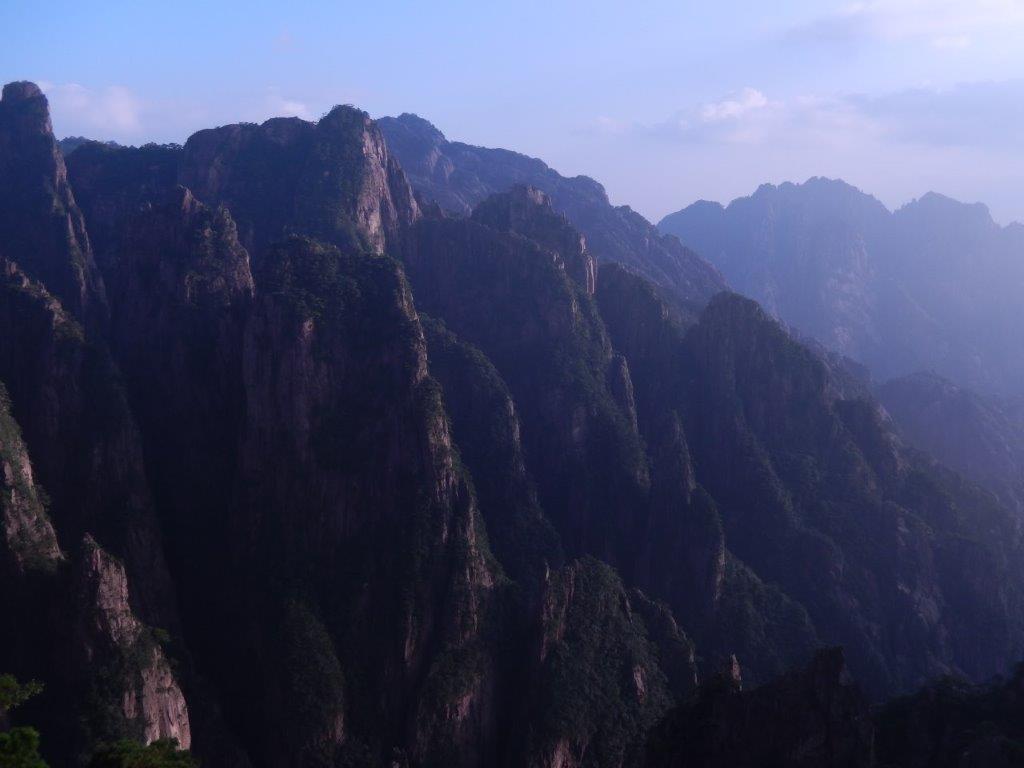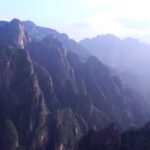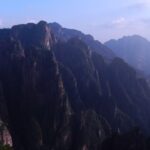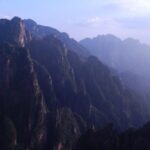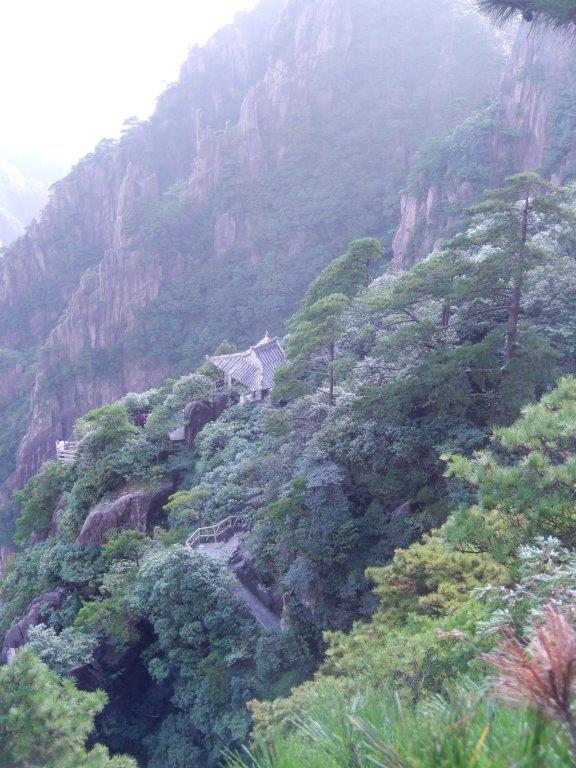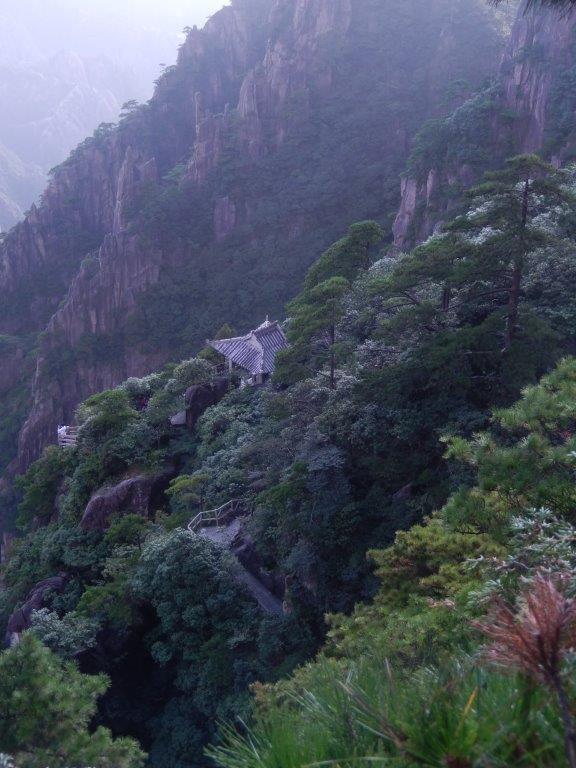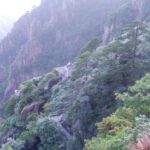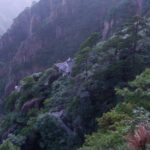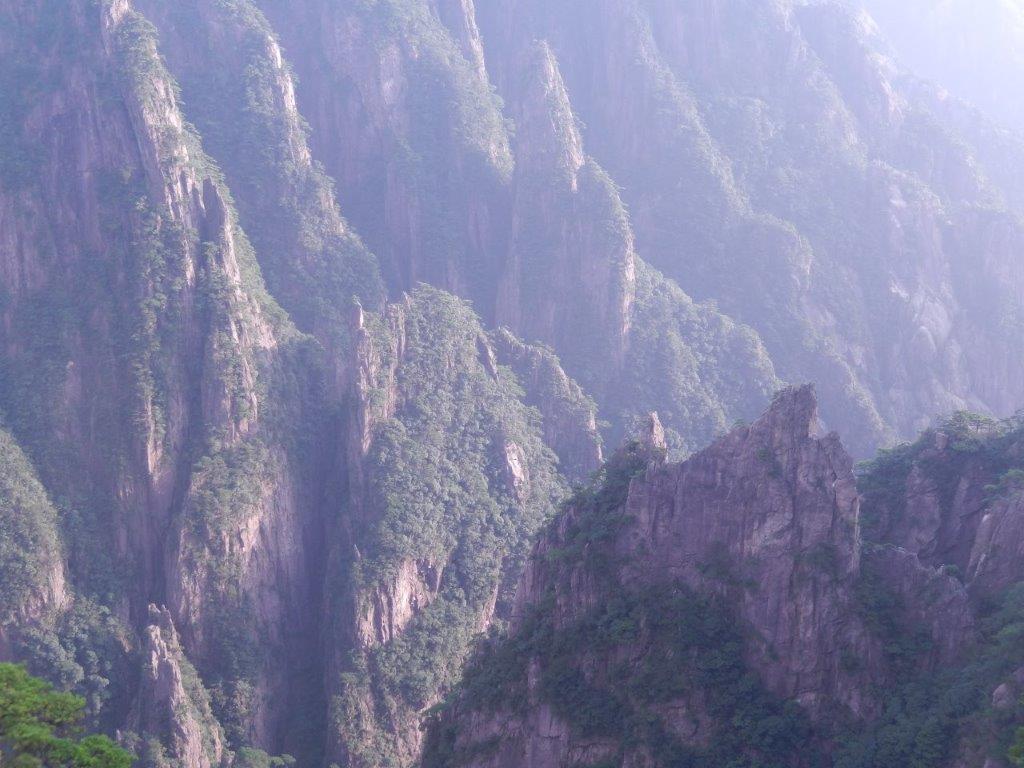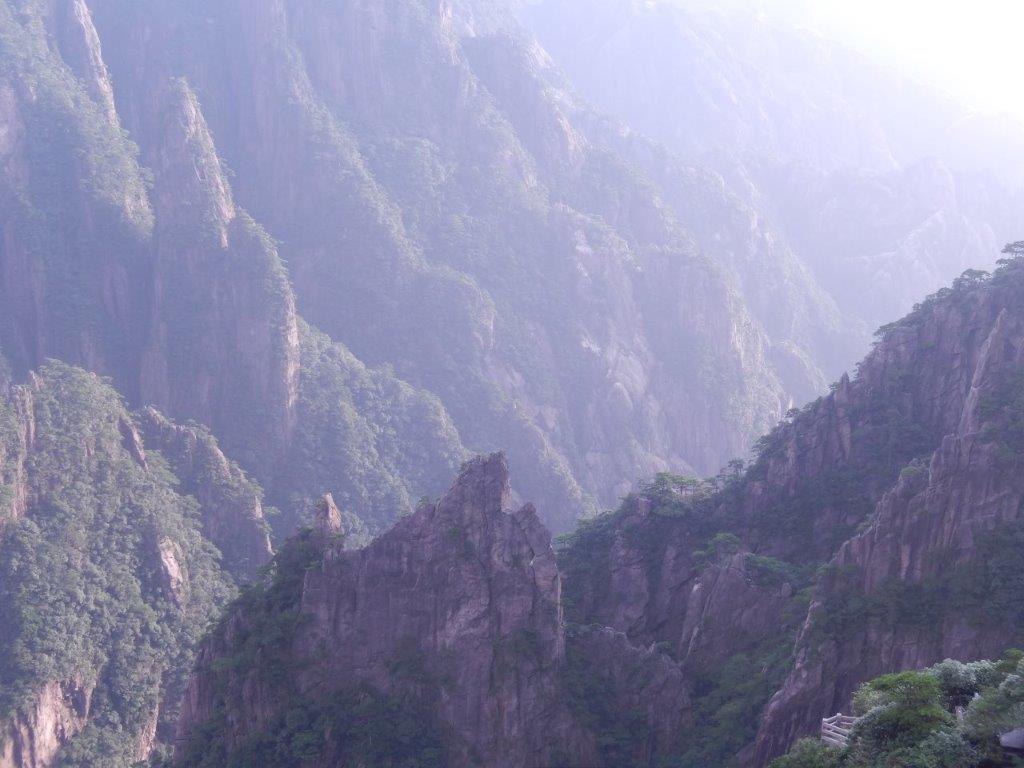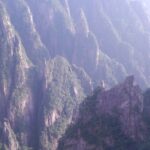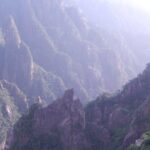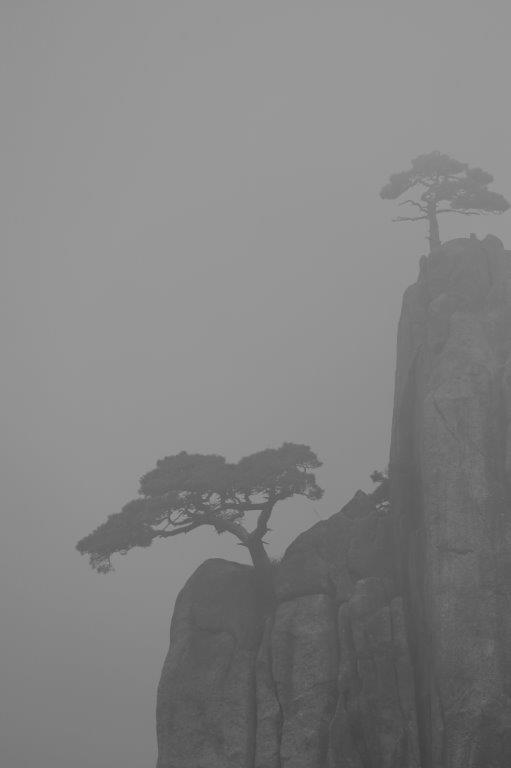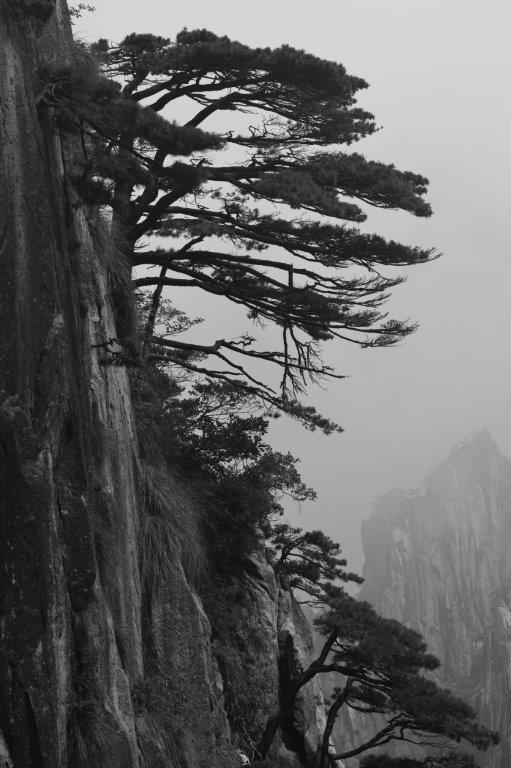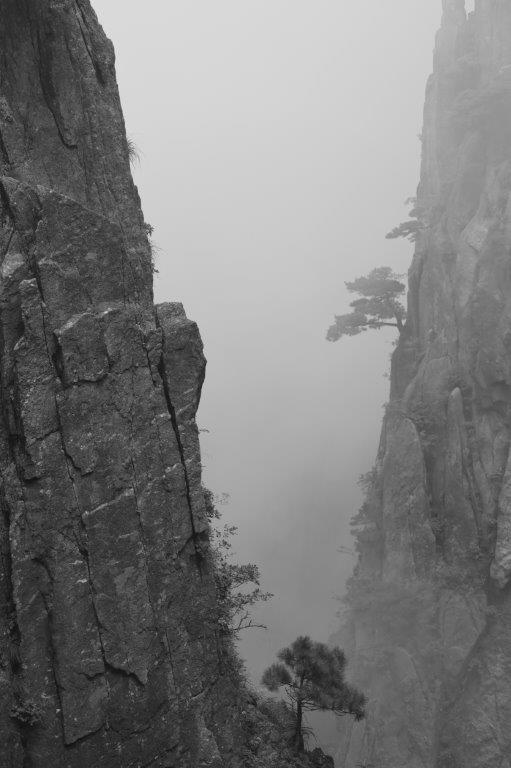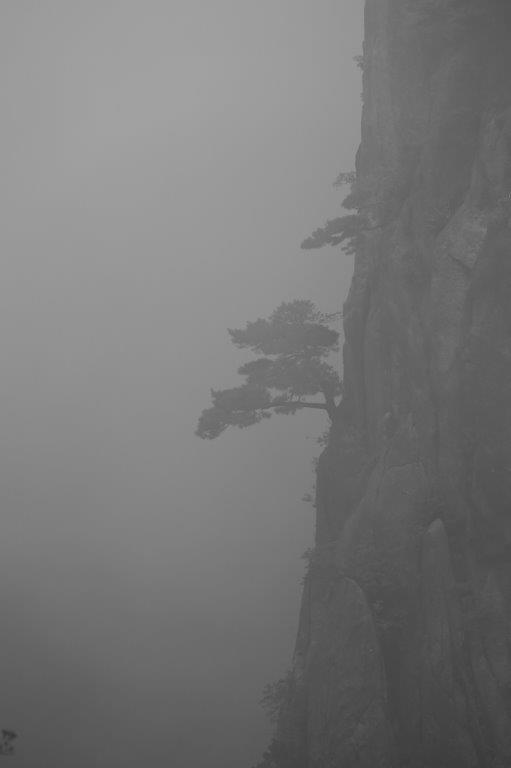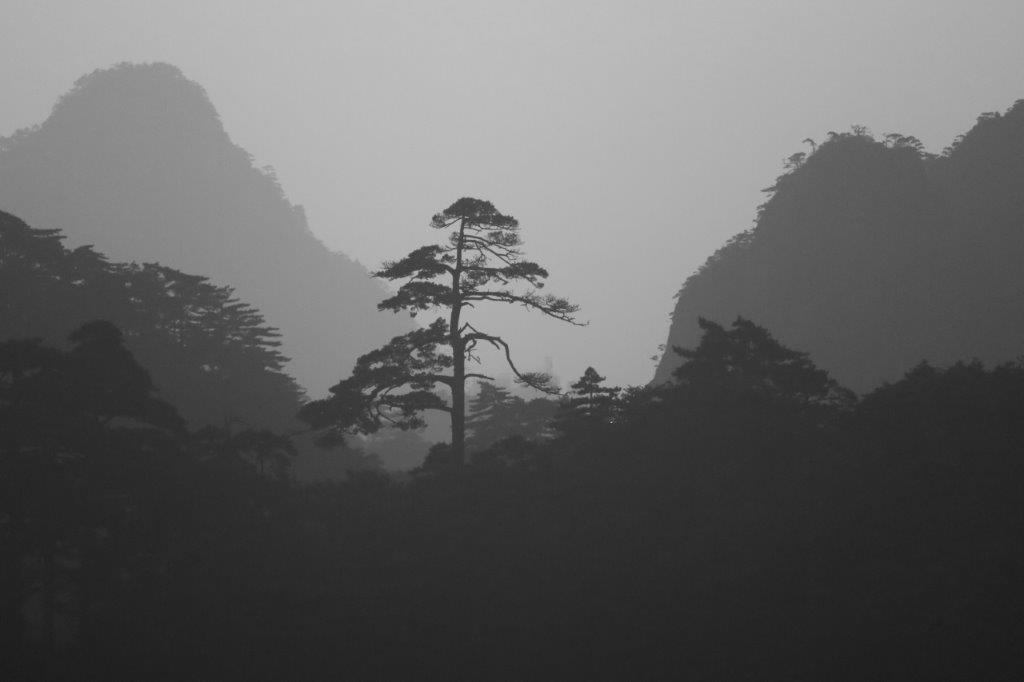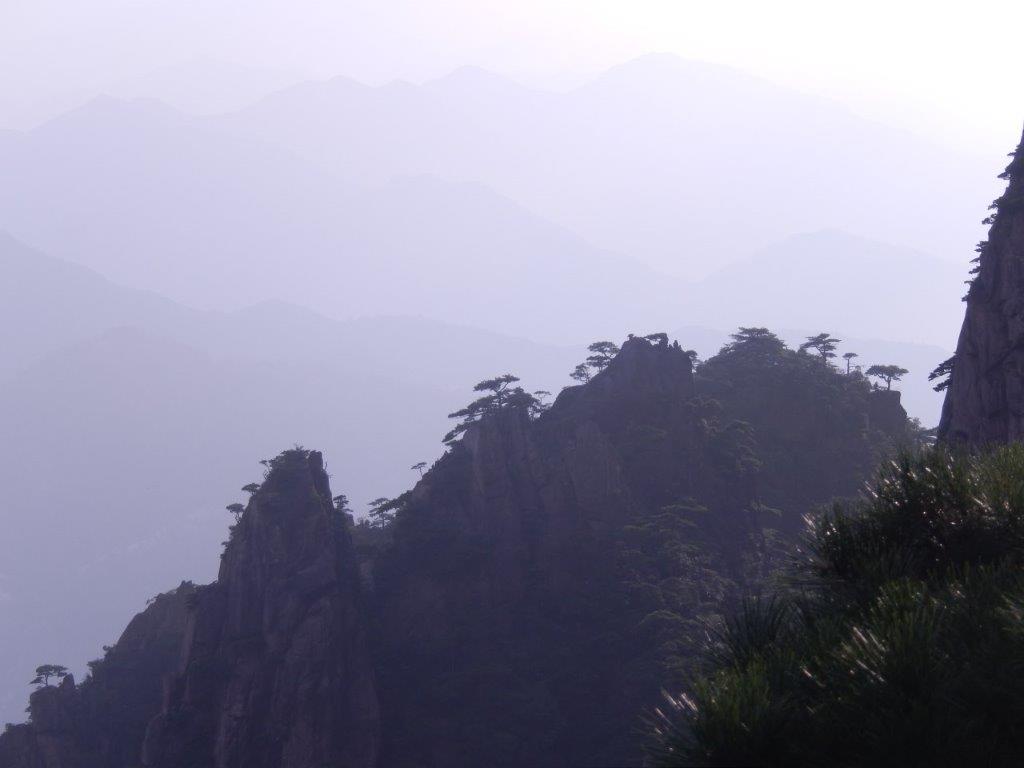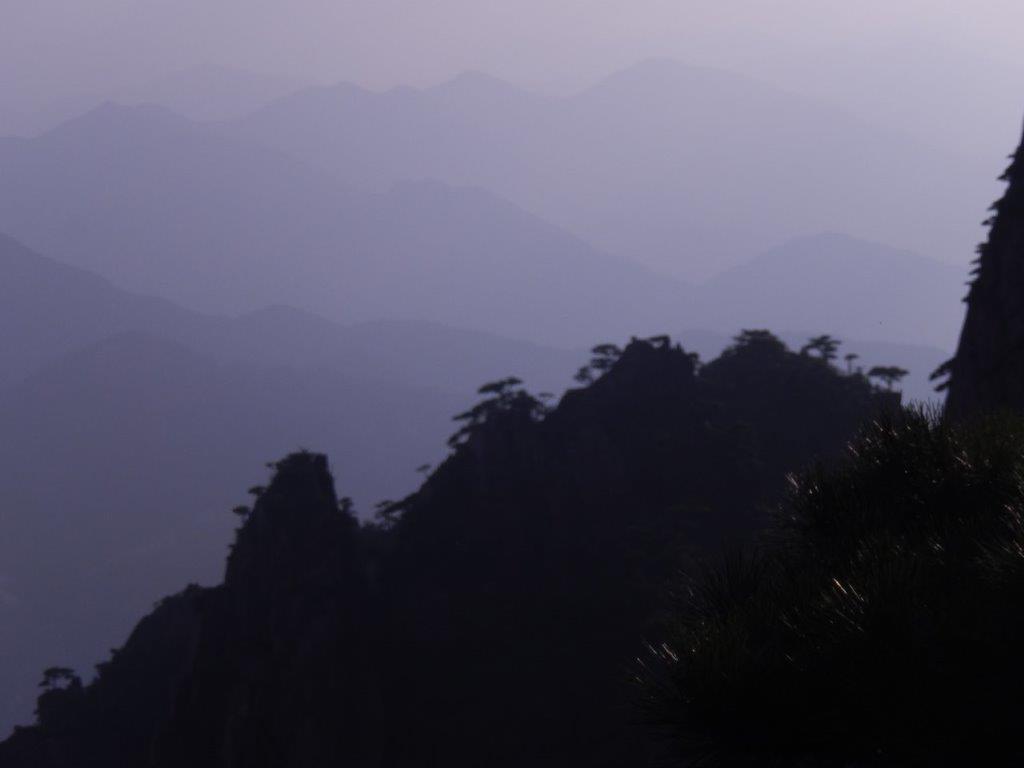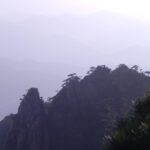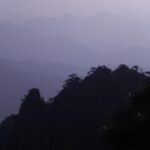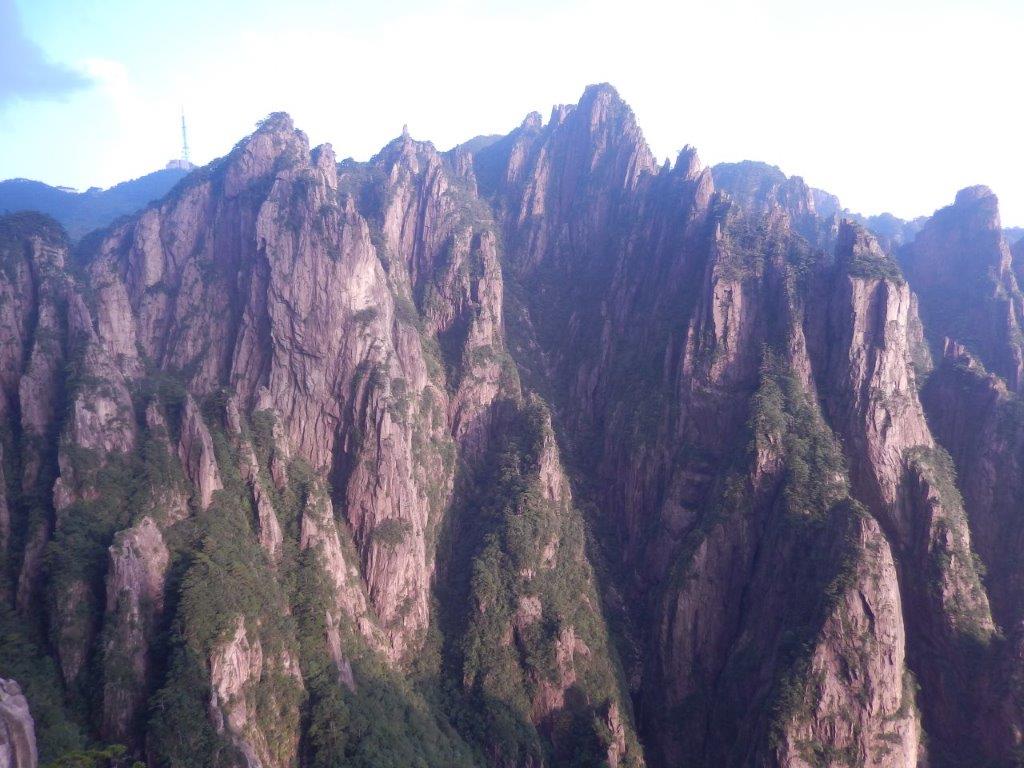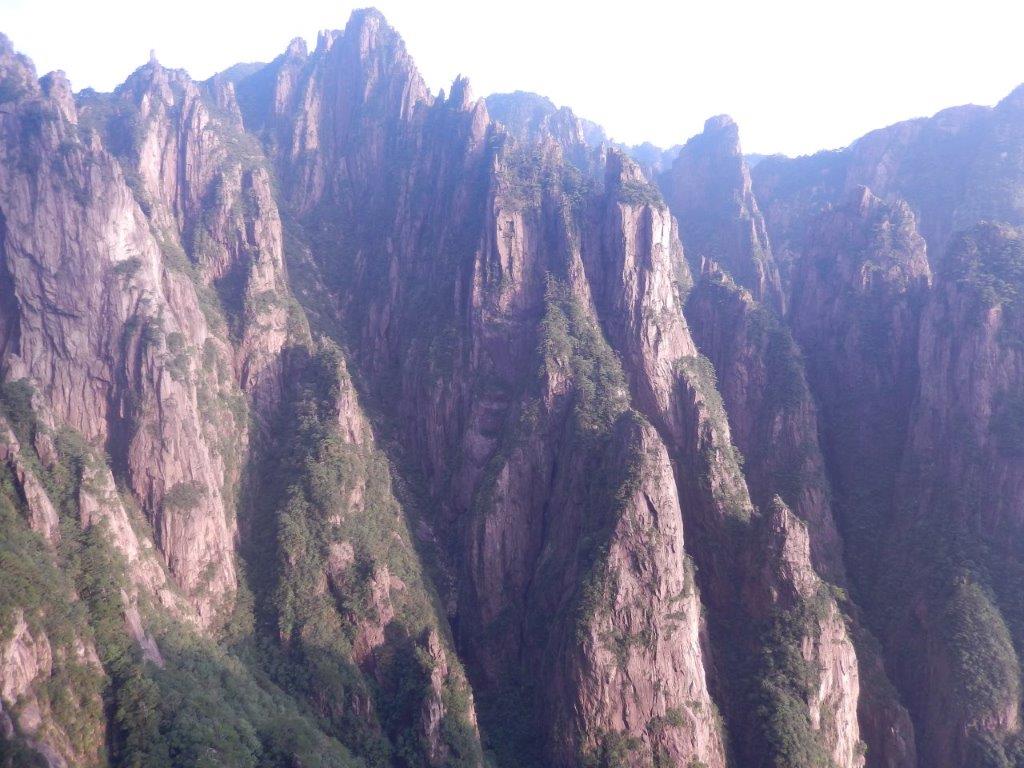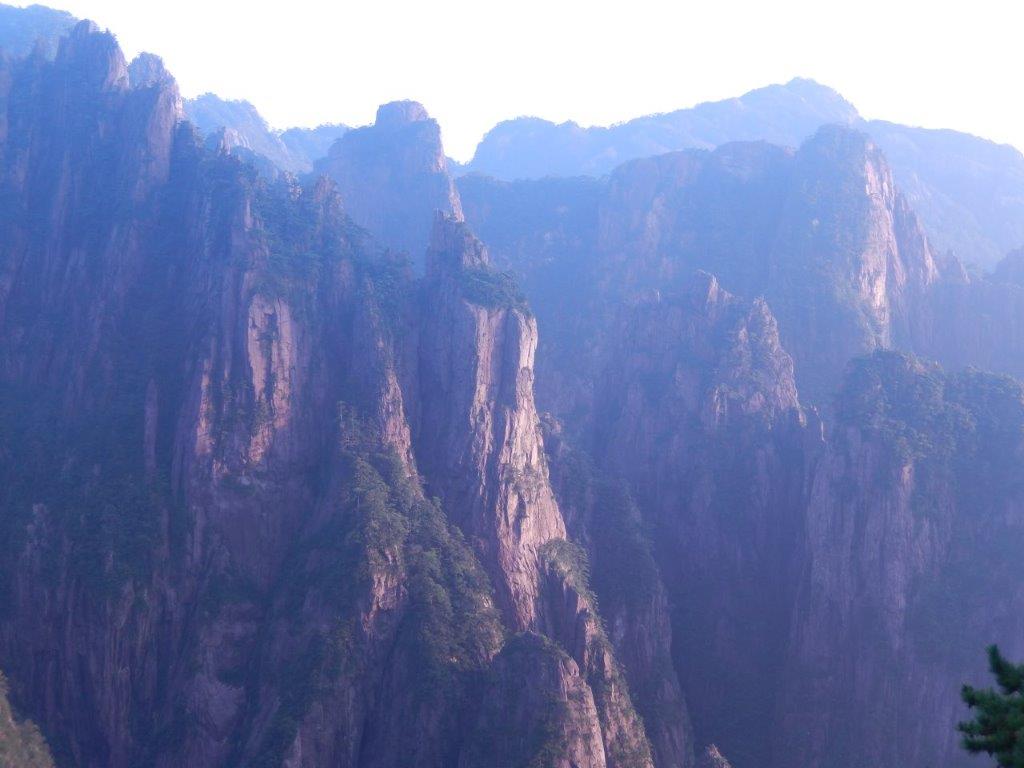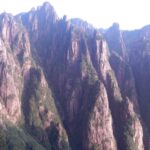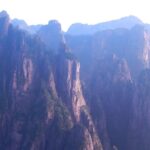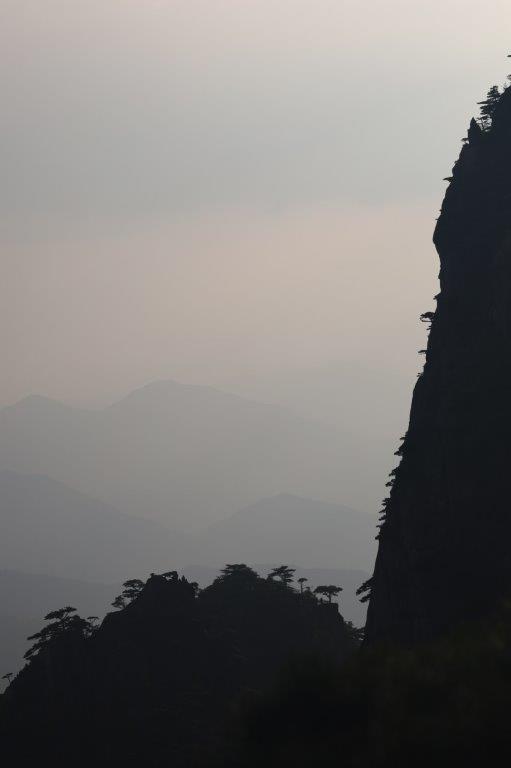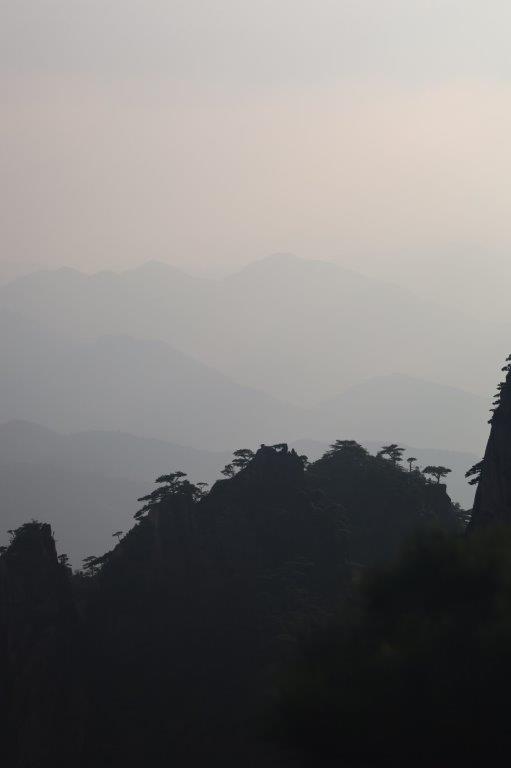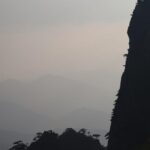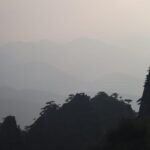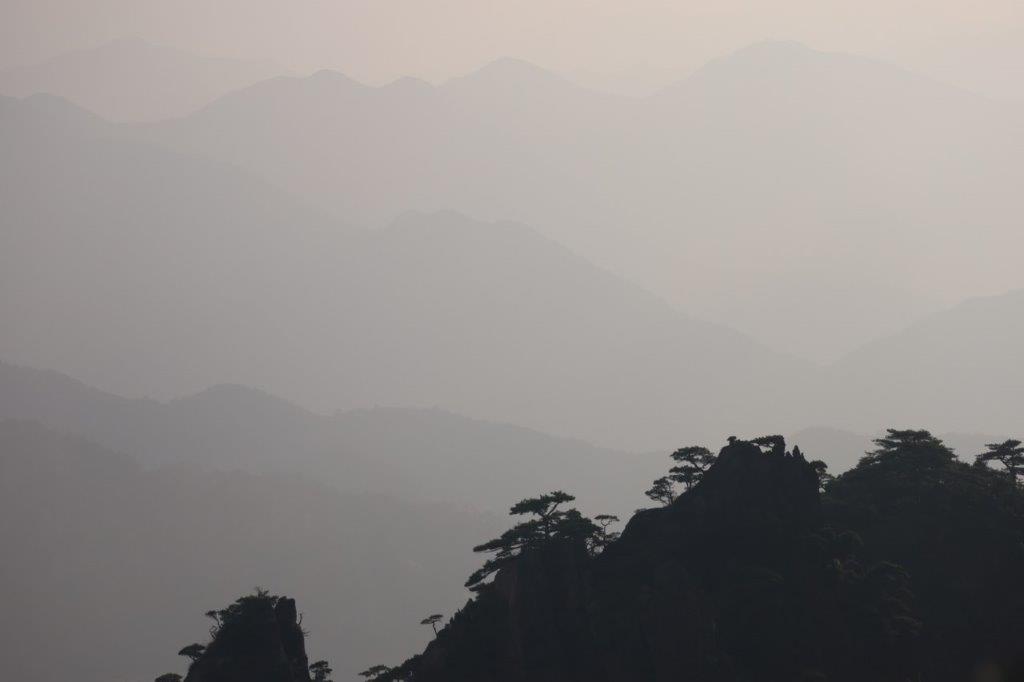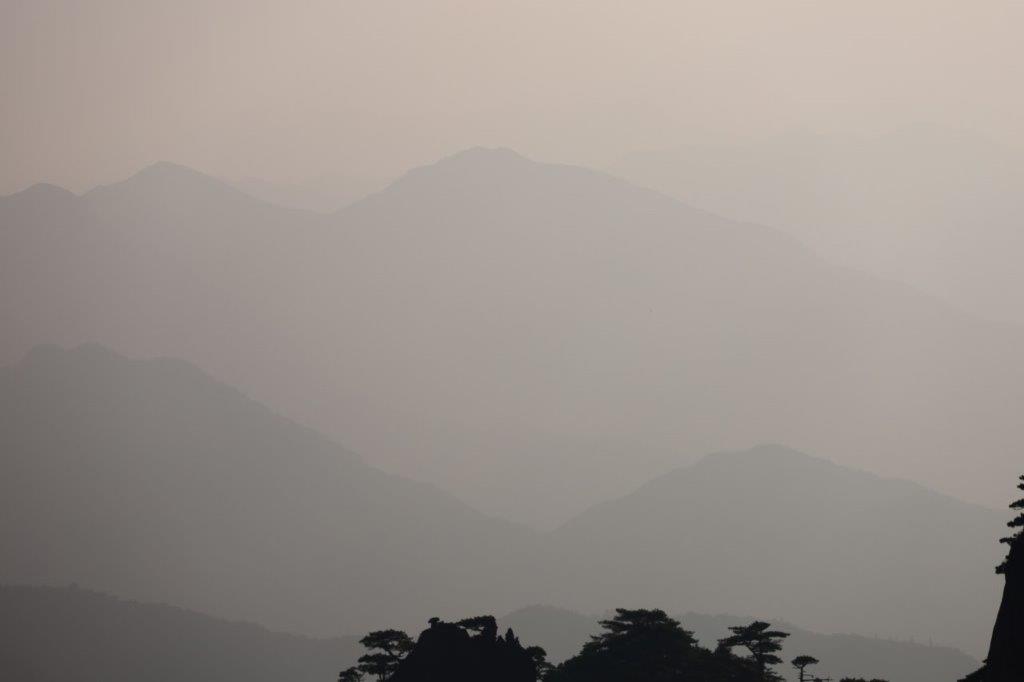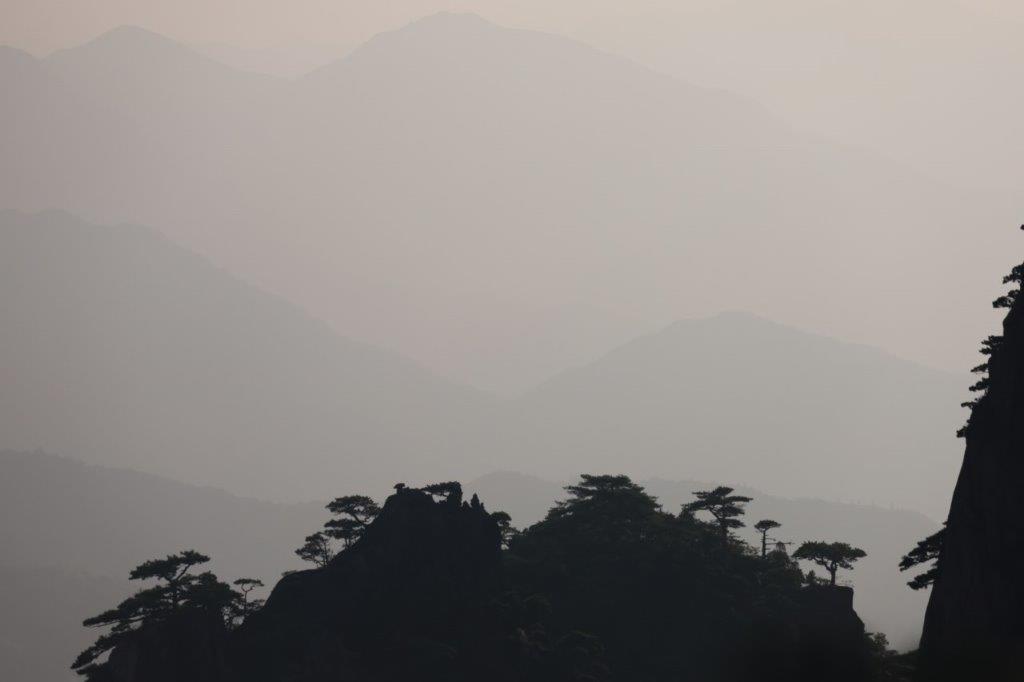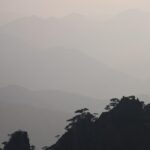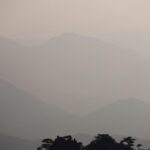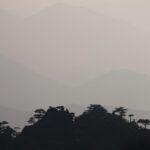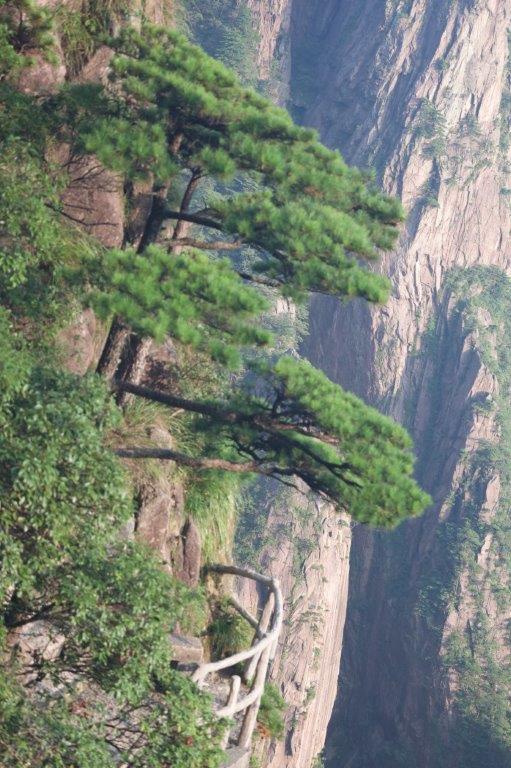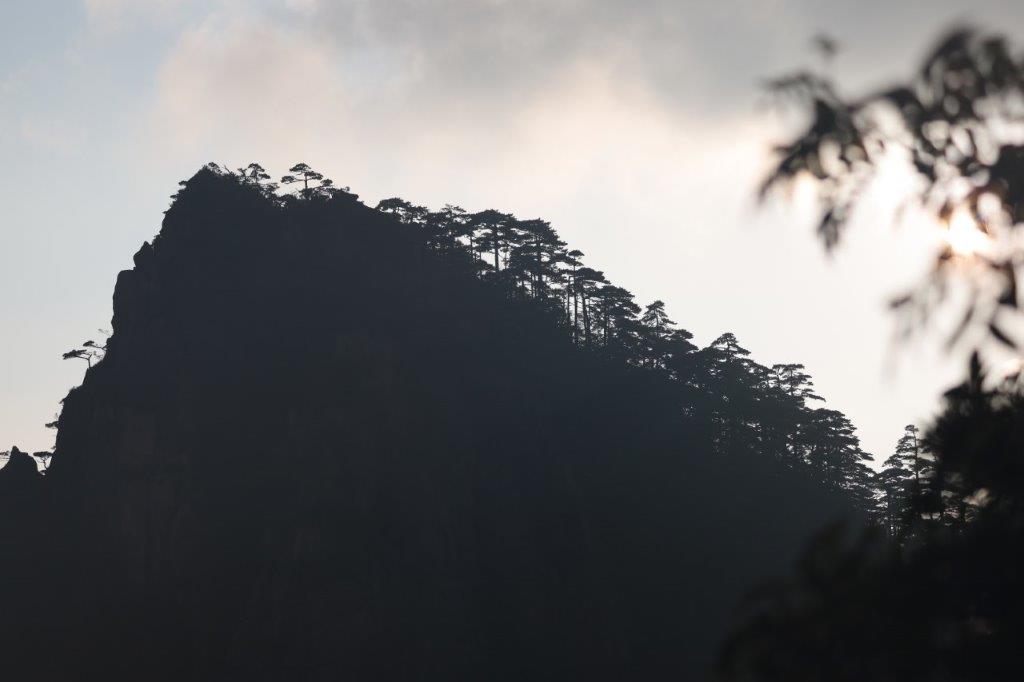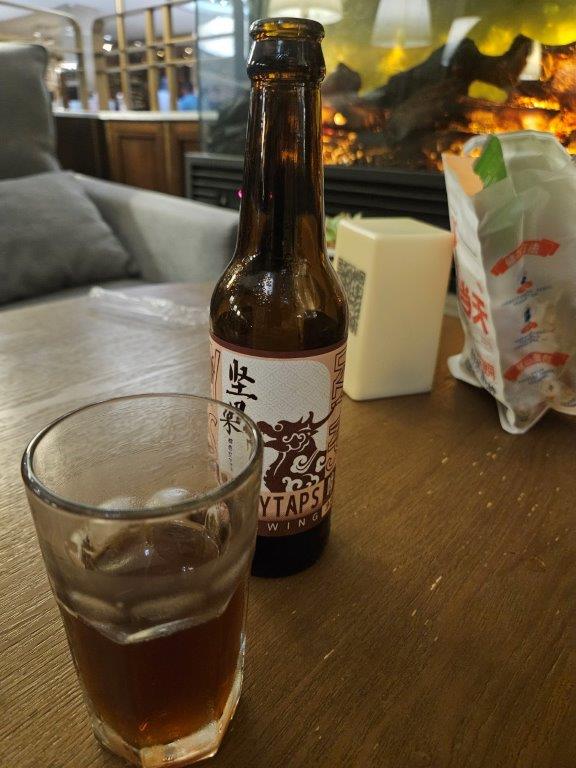7. China/Anhui: Huangshan Mountain Walk 2: The Great West Sea Canyon and Chinese Landscape photography… (Huangshan National Park / UNESCO World Heritage)
Sunset at Huangshan Mountain
Later in the afternoon at about 15.00 o’clock, The Wandelgek started his 2nd walk of the day in the Huangshan Mountains…
This time he walked from the hotel toward the Great West Sea Grand Canyon where he was going to pick a spot to view the sunset.
On the road he saw many strange rock formations that obviously had triggered someone’s mind to come up with an inspiring name, often just as strange as the rock formation’s shape itself. As a walker/hiker I loved this name and the rock’s shape was quite corresponding …
The Upside Down Hiking Boot
… this one was called.
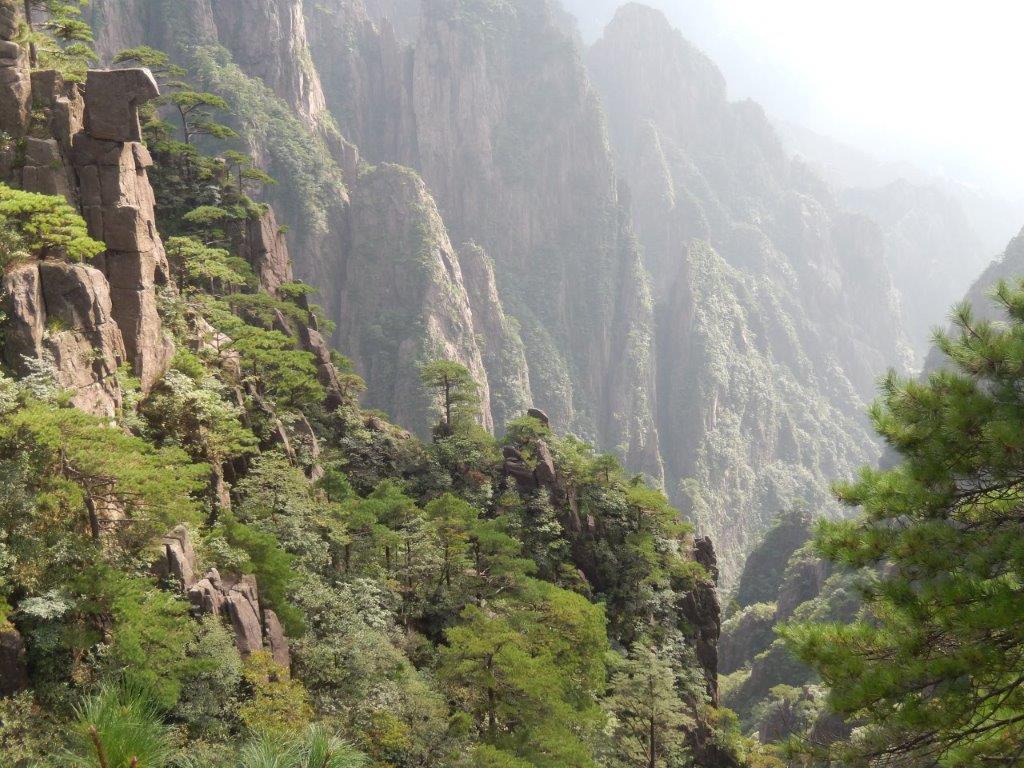 And yes, it was like someone who had been on a long walk and had sore feet, carelessly had thrown aside a boot after pulling it finally from the aching foot …
And yes, it was like someone who had been on a long walk and had sore feet, carelessly had thrown aside a boot after pulling it finally from the aching foot …
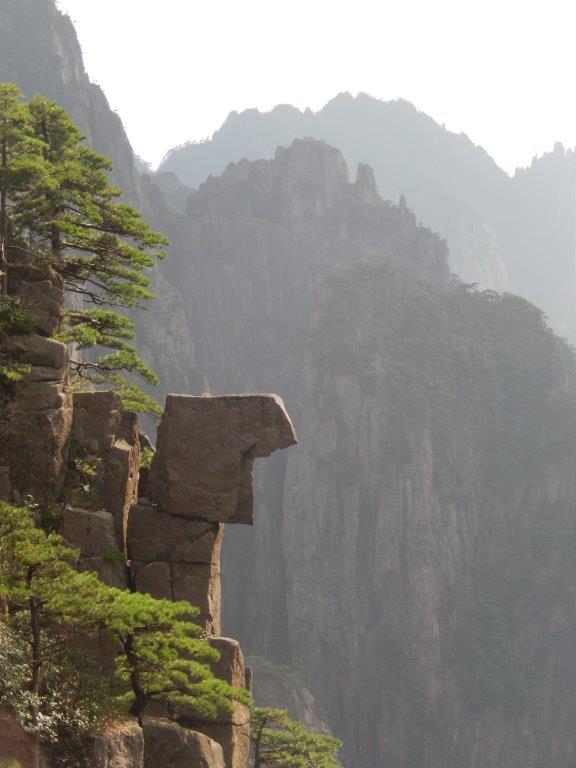 The sun was still quite high up in the sky …
The sun was still quite high up in the sky …
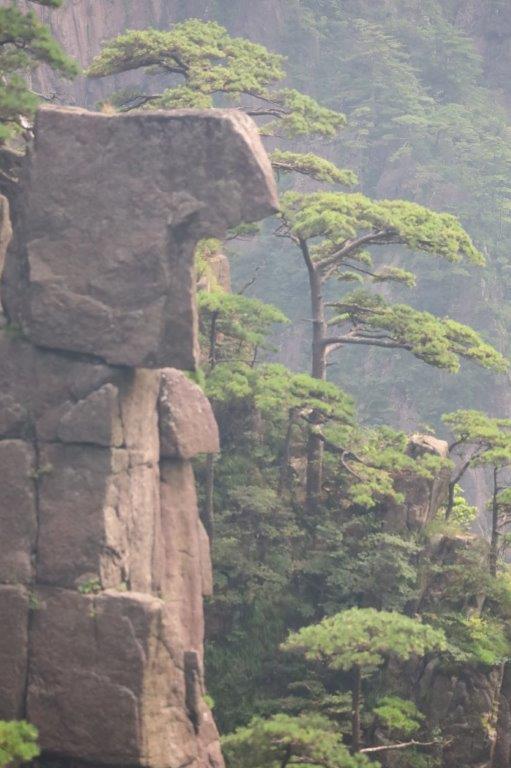 The rock could also be a little mouse, sniffing the air with its pointy nose and having its paw beside the head. Oh my, the Chinese inventiveness is quite contageous …
The rock could also be a little mouse, sniffing the air with its pointy nose and having its paw beside the head. Oh my, the Chinese inventiveness is quite contageous …
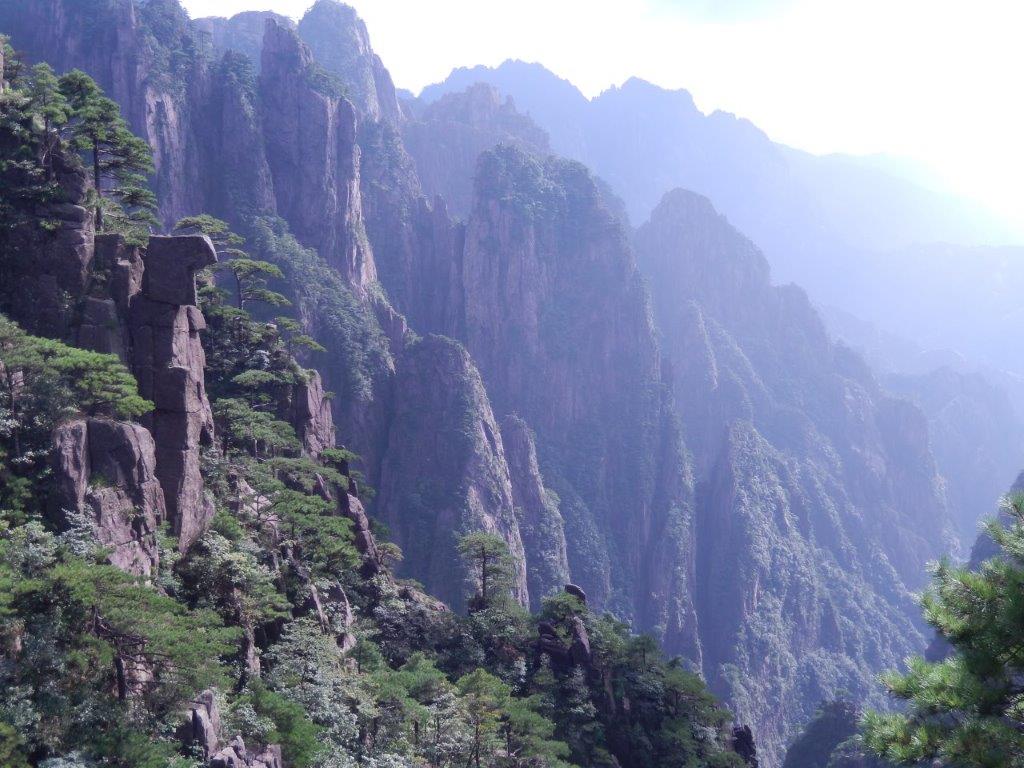 And then there are the pines …
And then there are the pines …
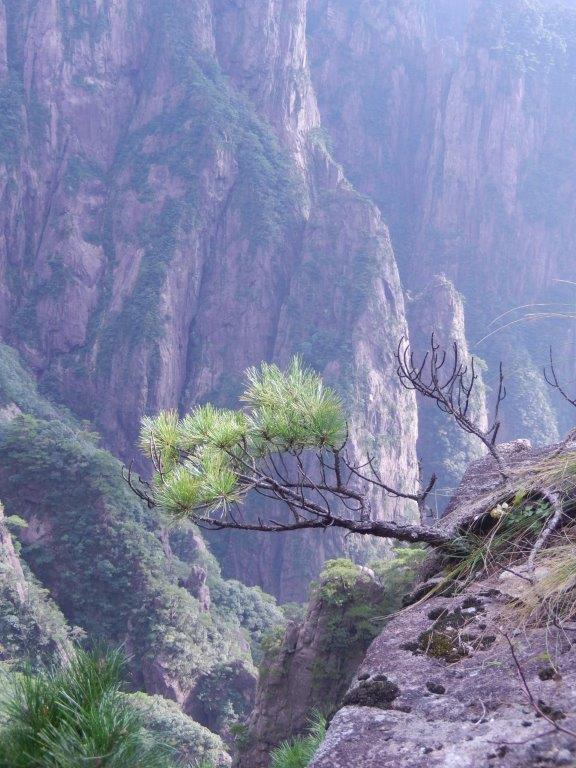 There were pines everywhere. The steepest slopes and believe me, there were a lot of those in this area, still were no match for these pines…
There were pines everywhere. The steepest slopes and believe me, there were a lot of those in this area, still were no match for these pines…
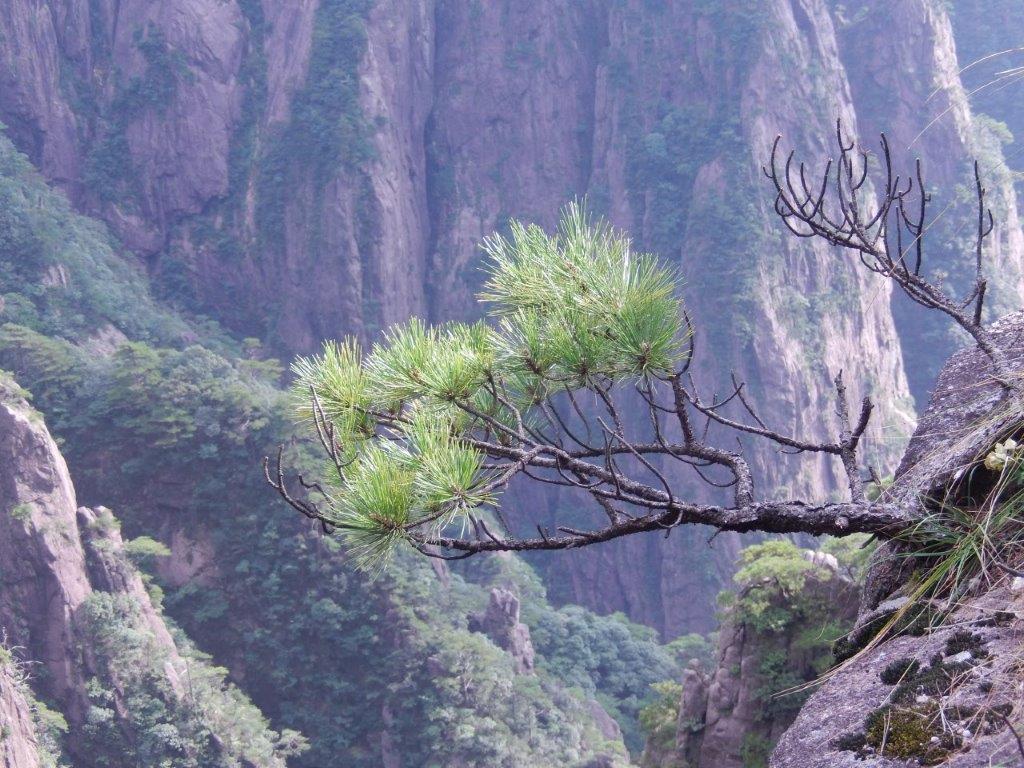 The area became canyon-like as The Wandelgek reached the:
The area became canyon-like as The Wandelgek reached the:
Great West Sea Canyon
The West Sea Grand Canyon or Xihai Grand Canyon, is a network of steep steps that leads travelers through ever-changing landscapes of pine forests and rocky crags, offering incredible views over Xihai. The scenic area offers some of the best scenery on the already scenic Yellow Mountains. West Sea Grand Canyon is a hiker’s and a photographer’s paradise as well …
 The steep mountain slopes overhere were almost completely vertical and still the pine trees kept growing there.
The steep mountain slopes overhere were almost completely vertical and still the pine trees kept growing there.
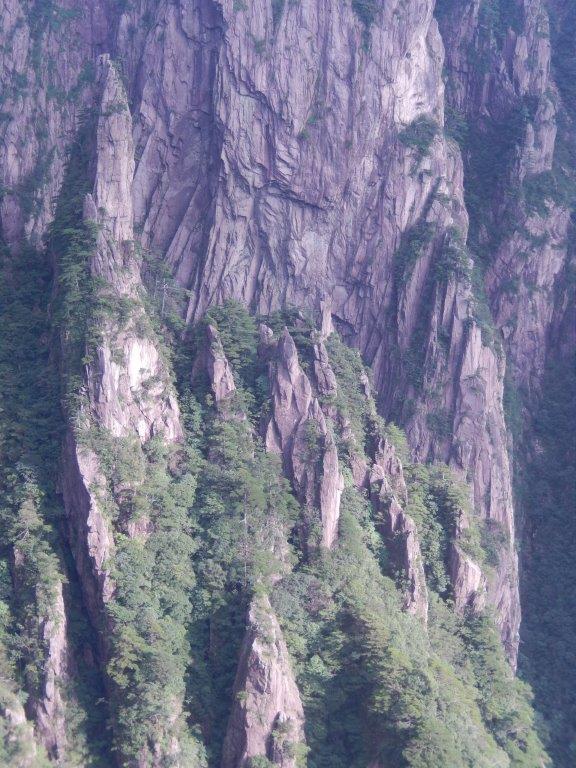 They clung to every crevice, nook and cranny they could find to insert their roots into, as deeply as possible …
They clung to every crevice, nook and cranny they could find to insert their roots into, as deeply as possible …
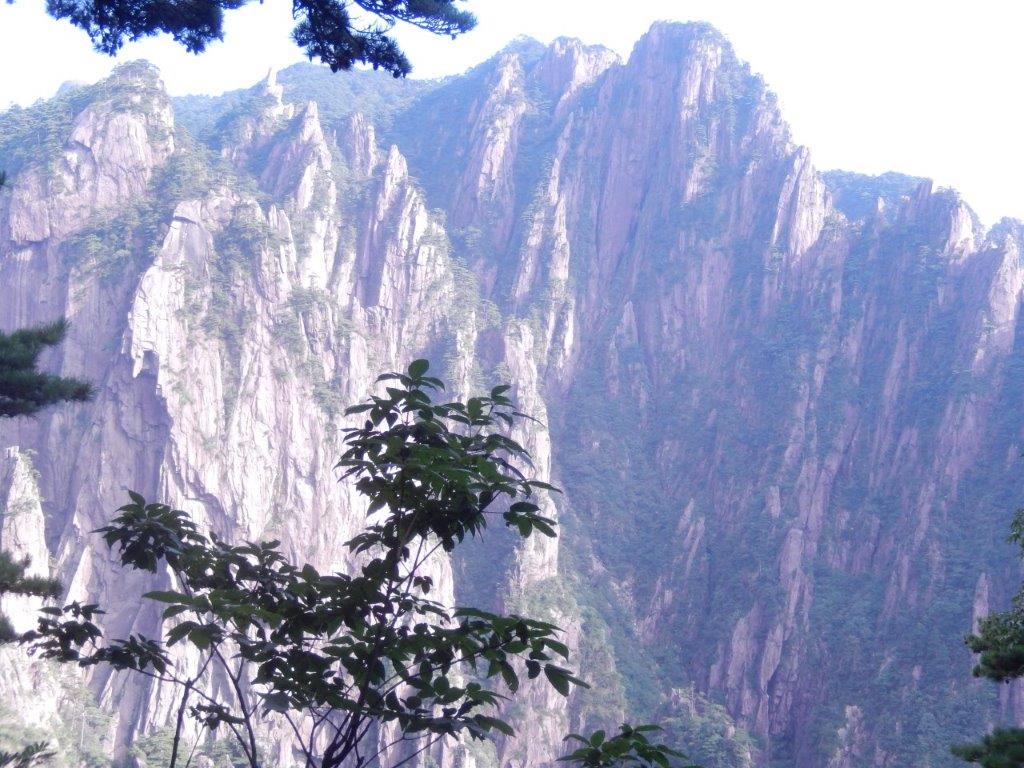 The pathways were again constructed and attached to the mountain in a death defying manner …
The pathways were again constructed and attached to the mountain in a death defying manner …
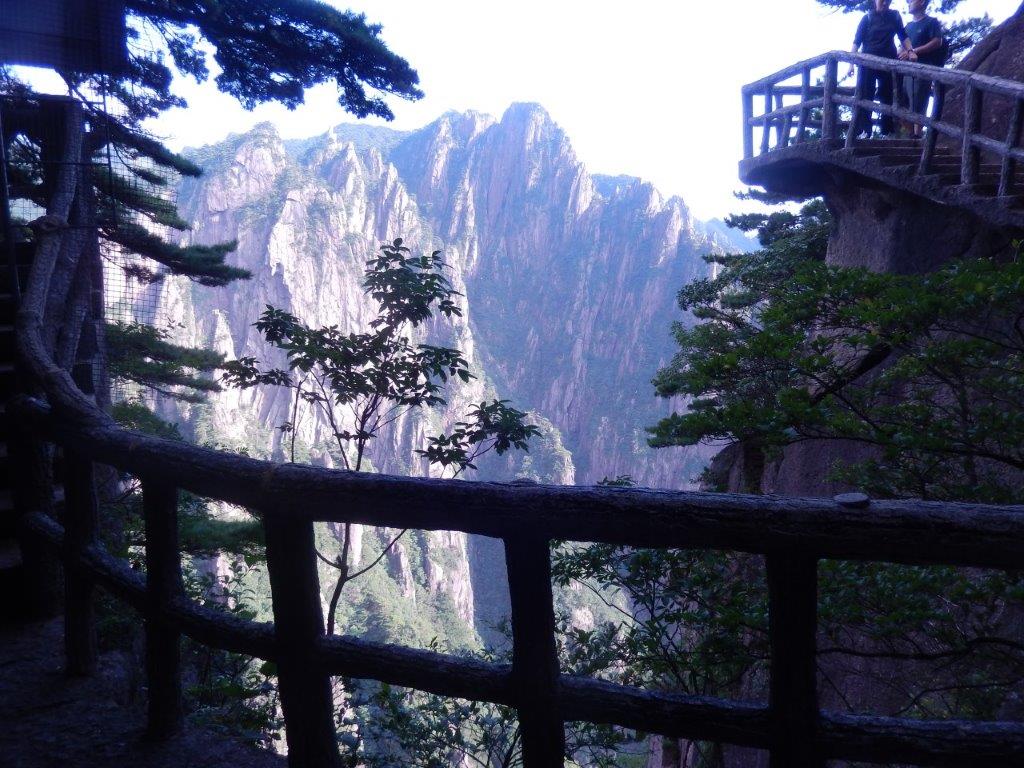 There were many viewing platforms and the one beneath was occupying the same space as this pine tree. These platforms are excellent stops for photographers …
There were many viewing platforms and the one beneath was occupying the same space as this pine tree. These platforms are excellent stops for photographers …
Their silhouettes are magnificent to behold …
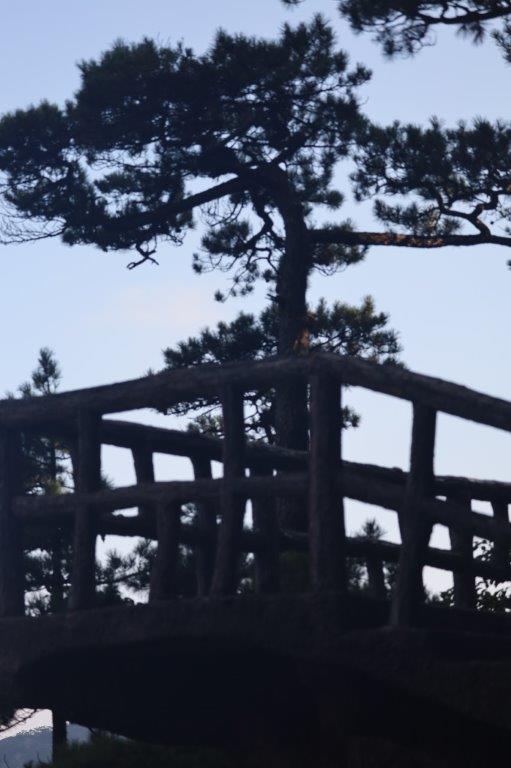 As are the mountains, rolling far away from lighter into darker hues until invisible …
As are the mountains, rolling far away from lighter into darker hues until invisible …
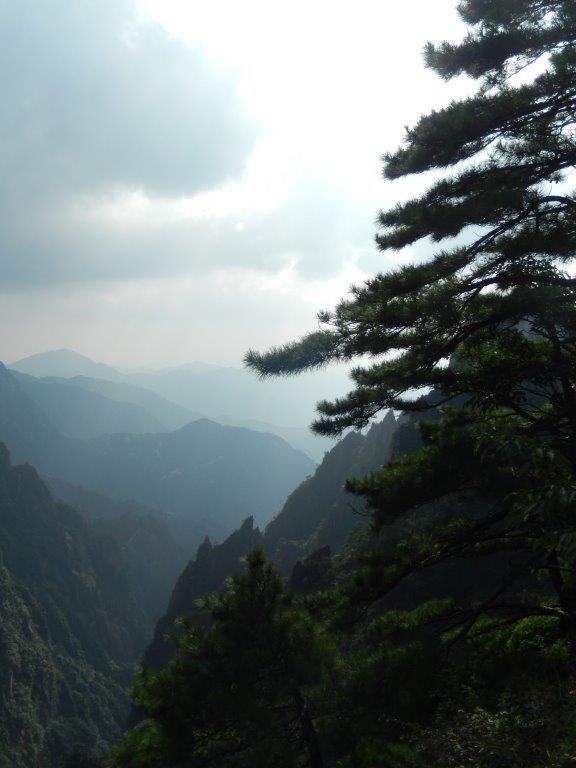 As a hobby photographer, this was almost challenging me to try and make photo’s of it as beautiful as possible. Here follows an impression of those dreamscape-like views …
As a hobby photographer, this was almost challenging me to try and make photo’s of it as beautiful as possible. Here follows an impression of those dreamscape-like views …
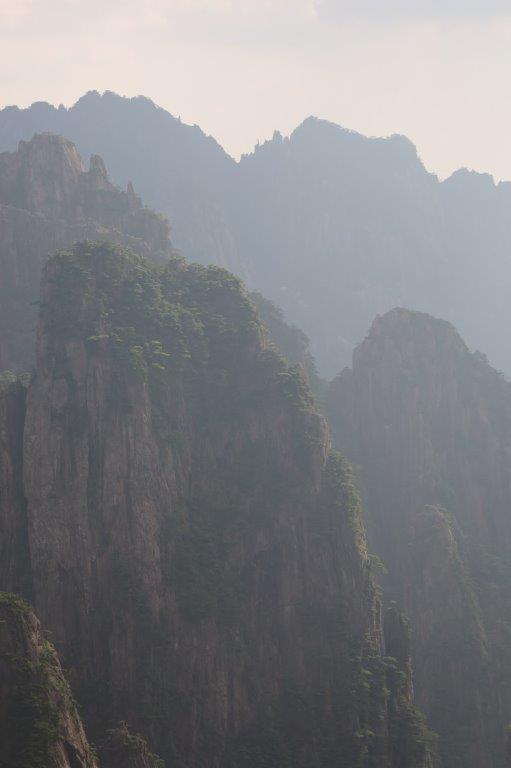 A lonesome pine tree clutching itself to the bare mountain slope …
A lonesome pine tree clutching itself to the bare mountain slope …
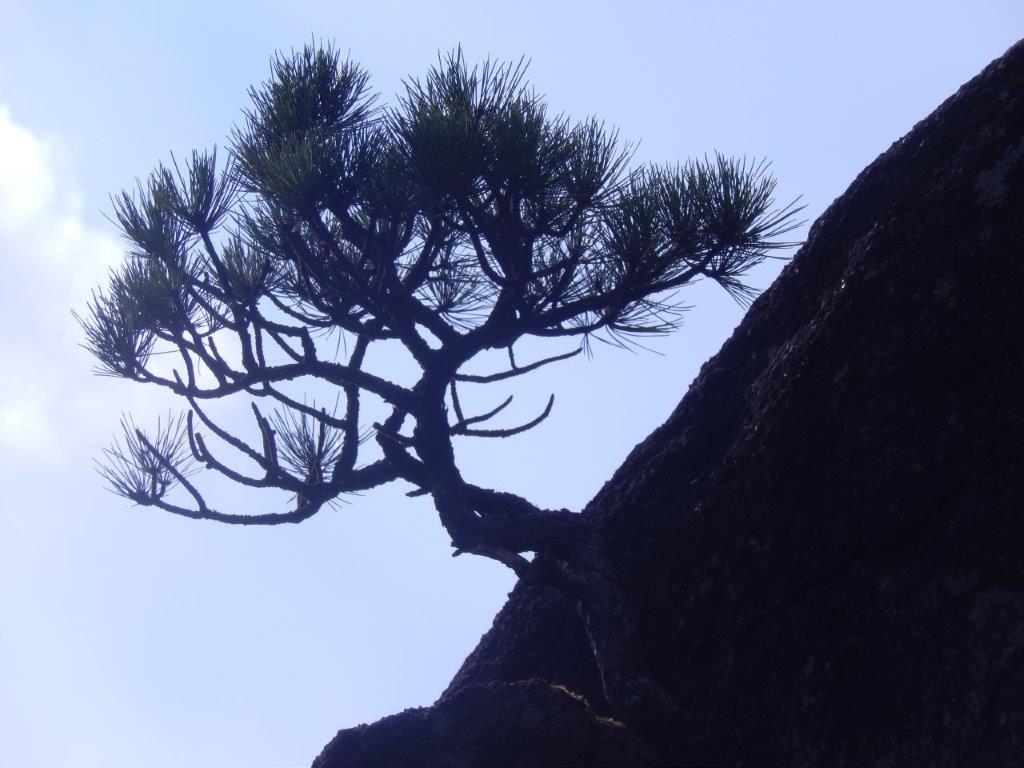 The Wandelgek arrived at a spot from where he could see the:
The Wandelgek arrived at a spot from where he could see the:
Split rock
If you watch close at the monolith-like rock below, you’ll see that it has split in two parts, probably caused by a pine tree’s roots growing on top of it …
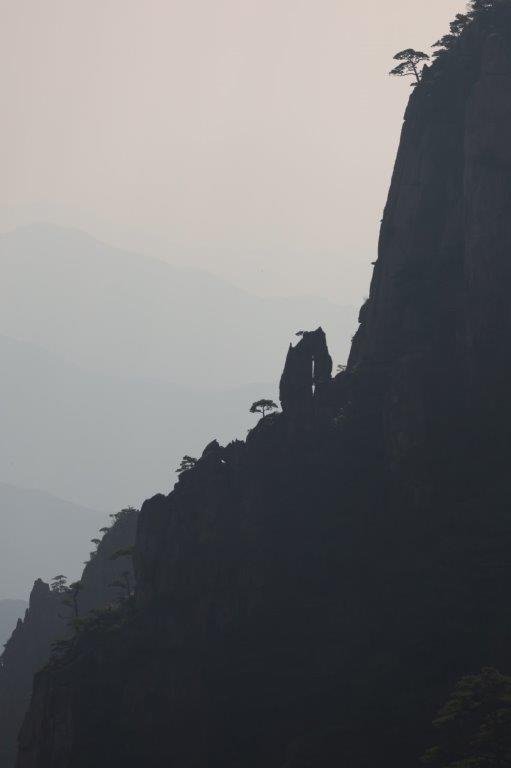 The Wandelgek also loved these silhouette like views, with all the tiny pine trees and rock shapes and the hues of the mountains beyond. It somehow reminded him of the miniature landscapes he created on his parent’s attic to accompany his miniature railway set …
The Wandelgek also loved these silhouette like views, with all the tiny pine trees and rock shapes and the hues of the mountains beyond. It somehow reminded him of the miniature landscapes he created on his parent’s attic to accompany his miniature railway set …
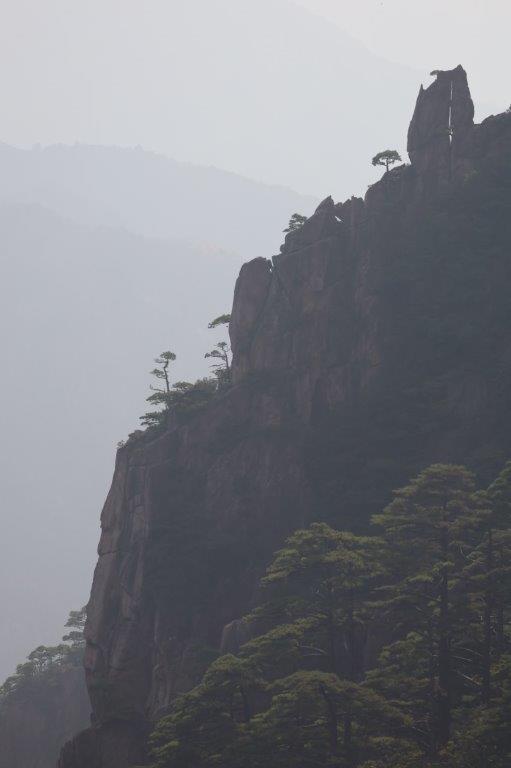 But if this could be done on a small scale, then why not much bigger?
But if this could be done on a small scale, then why not much bigger?
Ravine
The next part of the walk was through a very narrow crack in the rocks but it was quite long and not without danger. The4e were signs on the rock walls informing visitors of the dangers of sudden rockfall and on the way back The Wandelgek did notice fallen rocks that had not been there before …
After passing through this steep narrow crack, The Wandelgek arrived in a bright and sunny area with steep canyon like walls and all sorts of oddly shaped rocks and boulders spread over the area …
This rock e.g. looked like a toddler had piled some rocks upon eachother and it was not quite horizontal…
Some views really were reminiscent of those seen on internet of The Grand Canyon in Arizona, but everyting here was less deep, smaller and it was of course not a real canyon but a canyon-shaped ravine.
These little spots at the edges of rock pillars or in this case rocks, where some accumelated sediment made it possible for some trees, bushesand grass to grow, were like tiny gardens. The pine trees often were similar to Japanese Bonsai trees, because of their odd shapes…
The Wandelgek ventured deeper and deeper into this magnificent canyon-like landscape, photographing every detail and every new view …
He felt tiny, looking at these ancient rock formations that had seen emperors of past dynasties visit them and even then had been there long before …
These surrounding gave the impression of walking through the layers of time itself …
The Wandelgek kept being astounded by how these pine trees clung to the steepest possible mountain slopes …
… and every time he saw a tree on a more impossible spot than last time, he was subsequently overruled when thinking such a tree couldn’t be in an even steeper spot …
The result was him just leaving wit one last thought: “WOW !!!”, over and over again.
… and still the mountain slopes got steeper and still the trees kept clinging to them. He could almost hear them crying in utter despair to get the attention od a brave mountaineer who would save them from their uncomfortable positions …
A small tunnel finally led …
… to the area where The Wandelgek was going to enjoy watching the sunset …
He started photographing the area as the sunlight started to wane and thus got much better for photographing …
Chinese Landscape Photography on Huangshan Mountain
China is among the most desirable locations in the world for landscape photographers. Its dramatic geography and rich culture mix to make a perfect recipe for photographers around the world. Within China there are countless locations which are worth photographing and all of those are very different from eachother and from other places in the world too. Some are even unique and can only be fond in China and some only in one location in China. Huangshan Mountain is such a unique place …
In my previous blogpost I explained about Shanshui, an ancient way of landscape painting, and its connection to Taoism, Confucionism and Feng Shui. Read more at:
and at:
Souvenir 011: Chinese Calligraphy and Painting Set – Ho Chi Minh City/Saigon, Vietnam, 2008
Shanshui (山水), literally translates into “mountain-water” in Chinese, is a philosophicalas well as an artistic concept of landscape representation, that has originates in ancient China. Deeply rooted in Confucianism and Taoism, it illustrates the relationship between humans and nature, seeking to capture both the spiritual essence of the landscape and its visual beauty.
There is an interaction between Shanshui and black-and-white photography, in which Shanshui is an intellectual legacy of ancestral China, imbued with tradition and spirituality, whereas black-and-white photography represents modernity and is a new way of seeing and capturing the world.
Despite their distinct origins, these two forms of art converge in the quest to capture the transcendence and beauty inherent in simplicity.
Principles of Shanshui Applied to Minimalist Photography
Shanshui is a traditional style of painting that emphasizes natural landscapes. This style is deeply rooted in Taoist and Confucian philosophy, valuing harmony between man and nature.
Although Shanshui and minimalist landscape photography are separated by centuries and differences in mediums, they share a common philosophy of simplicity, harmony, and an artistic approach that values essence and emotion over the literal representation of the landscape.
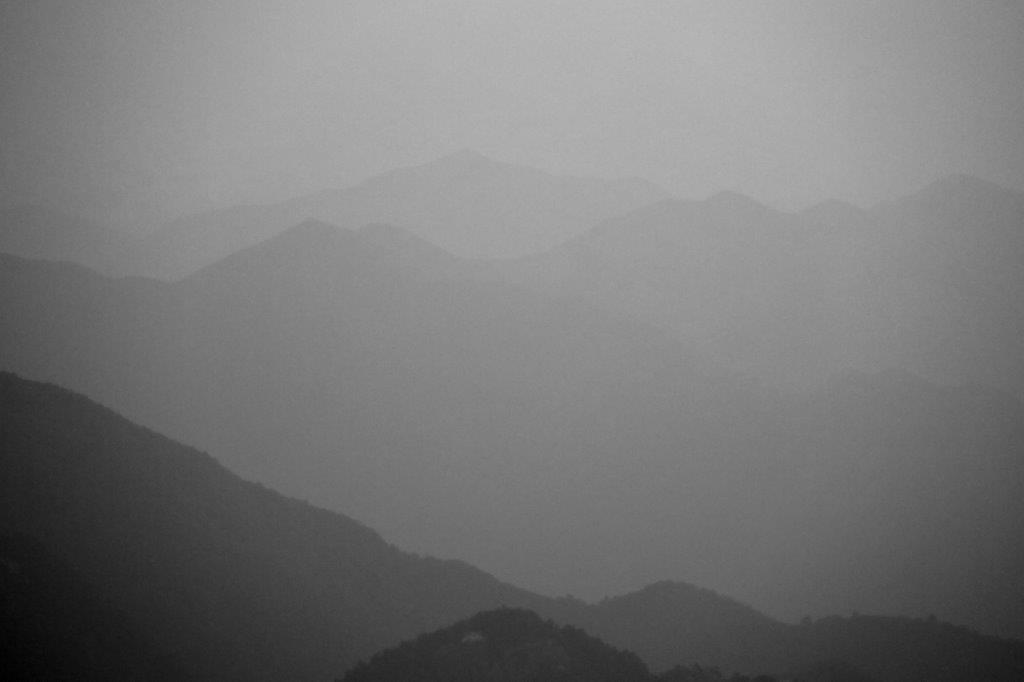 Taoism and Minimalism
Taoism and Minimalism
Shanshui is heavily influenced by Taoism and focuses on essence and simplicity, seeking to capture the spirit, rather than the literal form of nature. Similarly, minimalist landscape photography tends to reduce elements to the bare essentials, emphasizing the tranquility and purity of natural scenes. It uses emptiness as a means to do so.
Emptiness in Shanshui and Minimalist Photography
The emptiness in Chinese compositions and in minimalist photography is a crucial element that goes far beyond the absence of content. It is a space rich in meanings, balance, and potentialities, playing a fundamental role in the creation of a harmonious, thoughtful, and emotionally powerful work. This is why so many people are almost hypnotically drawn to watch for a very long timespan to these deceivingly simple paintings and photos.
The power of emptiness in Chinese compositions, or its importance in minimalist photography, can be observed through several aspects:
Philosophical Significance
In the tradition of Chinese Shanshui, emptiness is not simply an unfilled space, but a vital element that carries deep meanings. Inspired by Taoism, this emptiness symbolizes potential, the unmaterialized essence, and immateriality. It is the yin that contrasts and completes the yang of the physical elements of the painting.
Conclusion
The philosophy of Shanshui and minimalist photography, although distinct in their form and history, share a common quest: to capture the essence and harmony of nature. In these two arts, emptiness is not a lack, but a space of potentiality, a place where imagination and introspection can flourish.
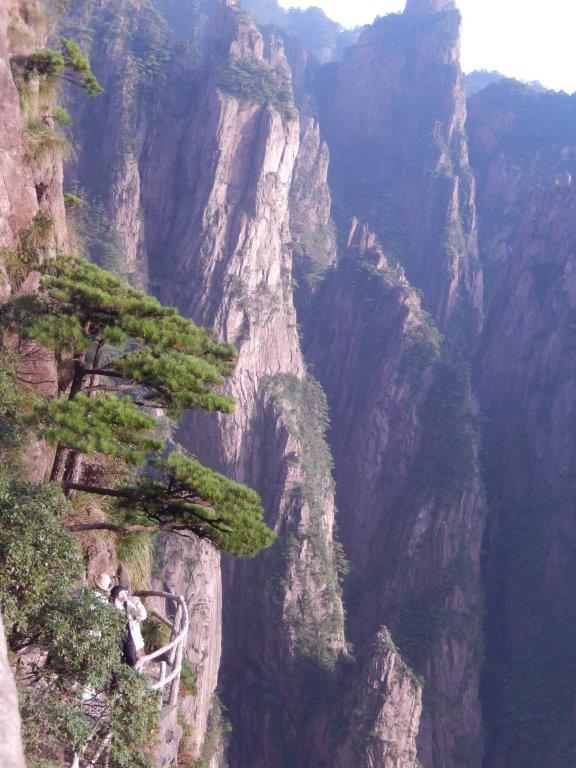 Painting and photography offer artists of each generation a platform to explore fundamental questions about nature, reality, and human existence. Thus, Shanshui remains not only a fundamental element of Chinese cultural heritage but also a subject of study and artistic exploration in constant evolution. It finds its resonance in everything minimalist, particularly in landscape painting and landscape photography.
Painting and photography offer artists of each generation a platform to explore fundamental questions about nature, reality, and human existence. Thus, Shanshui remains not only a fundamental element of Chinese cultural heritage but also a subject of study and artistic exploration in constant evolution. It finds its resonance in everything minimalist, particularly in landscape painting and landscape photography.
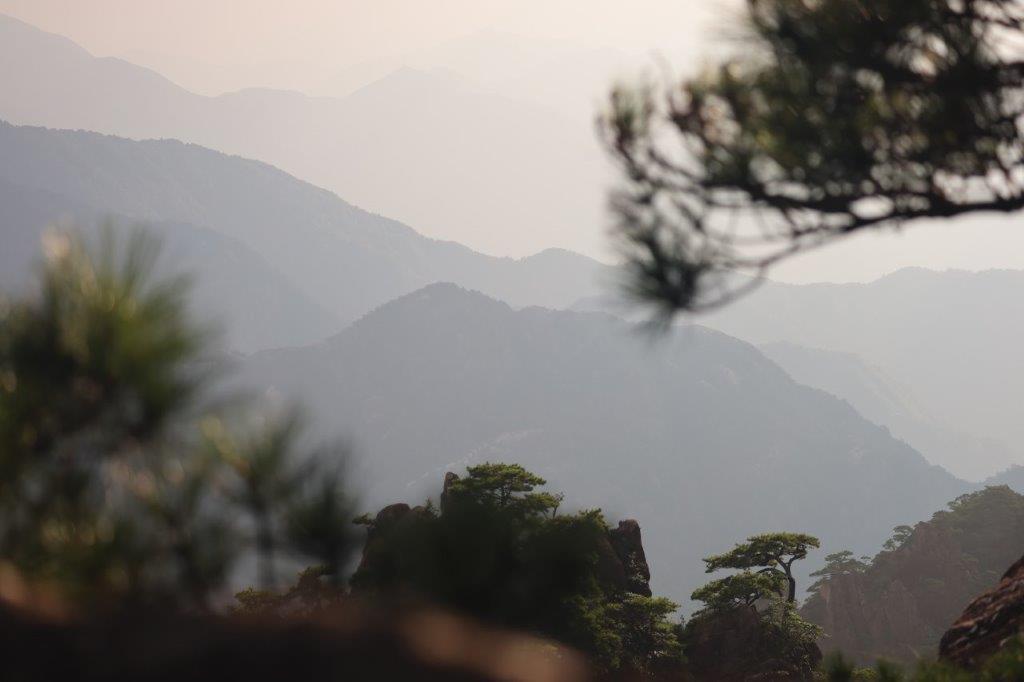 I’ll return to this topic some more in future blogposts of this journey through China, because it is one of the main reasons for me to go on this journey.
I’ll return to this topic some more in future blogposts of this journey through China, because it is one of the main reasons for me to go on this journey.
Sunset
As the light was waning, the contours, shades and colors of the rocks got prettier and prettier …
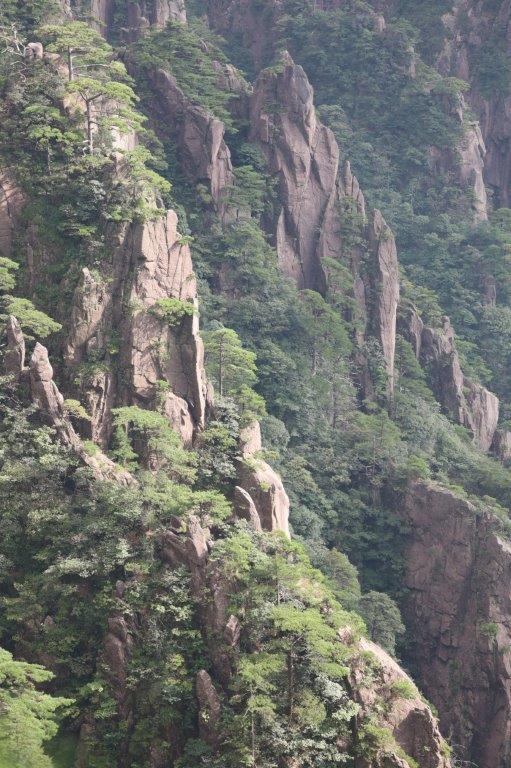 One effect of sundown is that sunglares anover exposures get less likely and colors first get deeper and then a strange thing happens …
One effect of sundown is that sunglares anover exposures get less likely and colors first get deeper and then a strange thing happens …
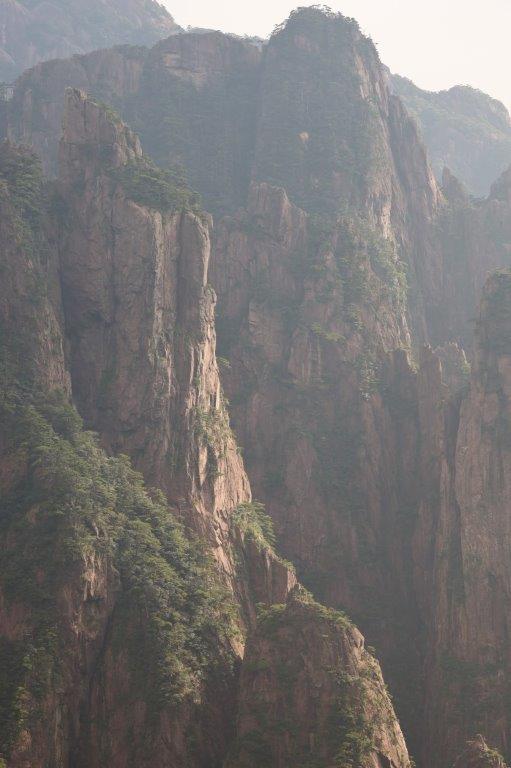 … reds, yellows and greens tend to disappear and make place, more and more for pinks, purples and eventually blues …
… reds, yellows and greens tend to disappear and make place, more and more for pinks, purples and eventually blues …
 The more north or south you get the slower and the longer this twilight lasts, the more you get toward the equator, the quicker and shorter it will last…
The more north or south you get the slower and the longer this twilight lasts, the more you get toward the equator, the quicker and shorter it will last…
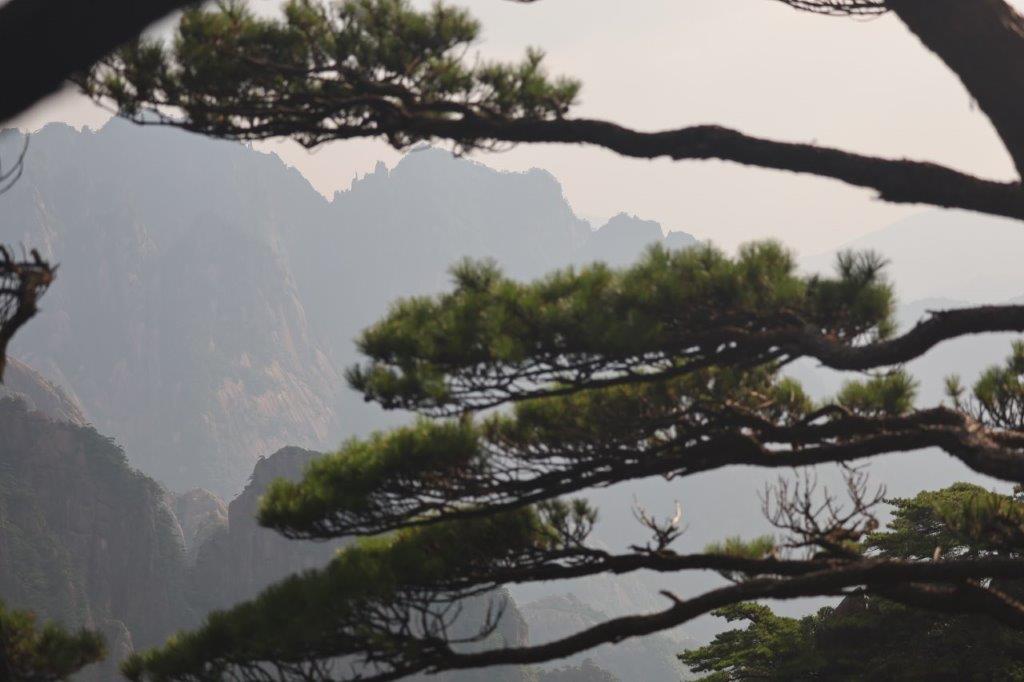 In Central China this time is still reasonable of length, in Greenland or Scandinavia it is really long and in East Africa it is very brief …
In Central China this time is still reasonable of length, in Greenland or Scandinavia it is really long and in East Africa it is very brief …
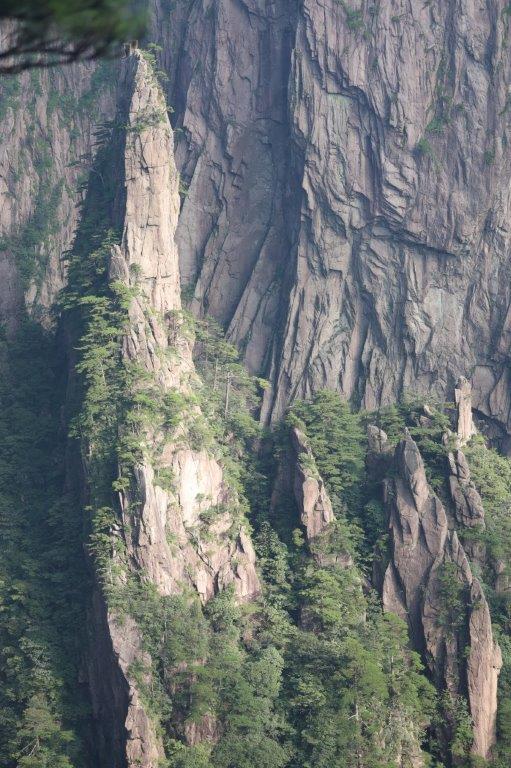 This is actually why I like travelling to these northern or far southern, Arctic or Antarctic regions so much…
This is actually why I like travelling to these northern or far southern, Arctic or Antarctic regions so much…
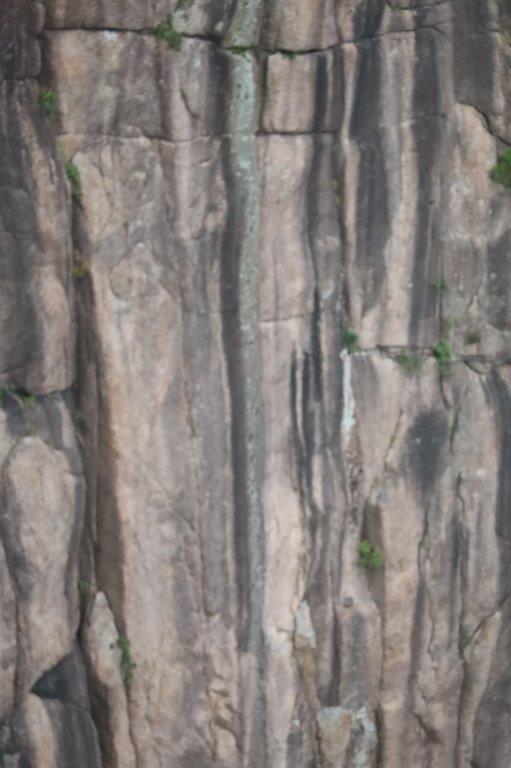 The Wandelgek is actually an evening type of person, meaning he likes rising late and becoming more active when evening and night tend to fall …
The Wandelgek is actually an evening type of person, meaning he likes rising late and becoming more active when evening and night tend to fall …
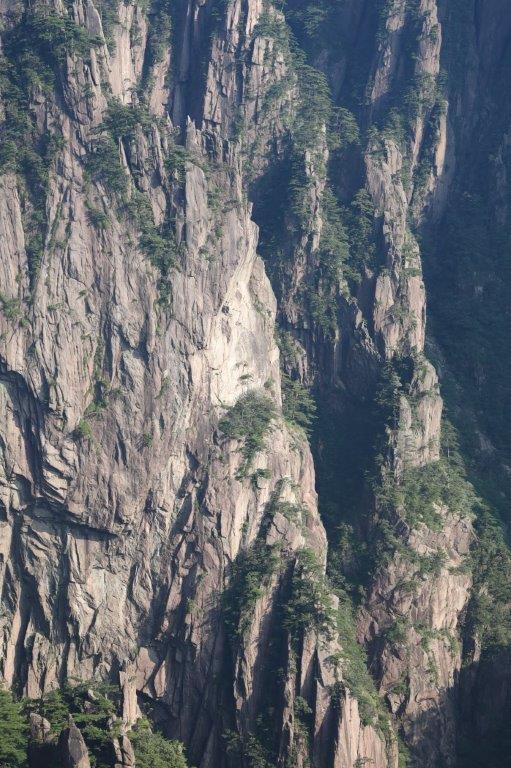 bLater in the evening and in the early stages of night, everything quiests down and in most places, even in large cities, society tends to slow down or even stop …
bLater in the evening and in the early stages of night, everything quiests down and in most places, even in large cities, society tends to slow down or even stop …
 This is also the best time to make great photo’s (although early morning is really good too).
This is also the best time to make great photo’s (although early morning is really good too).
As the sunlight got softer, The Wandelgek enjoyed photographing the strangest rock formation in the Great West Sea Canyon. The name Sea is again referring to the cloud sea that can occassionally be viewed from here. But regretfully not today…
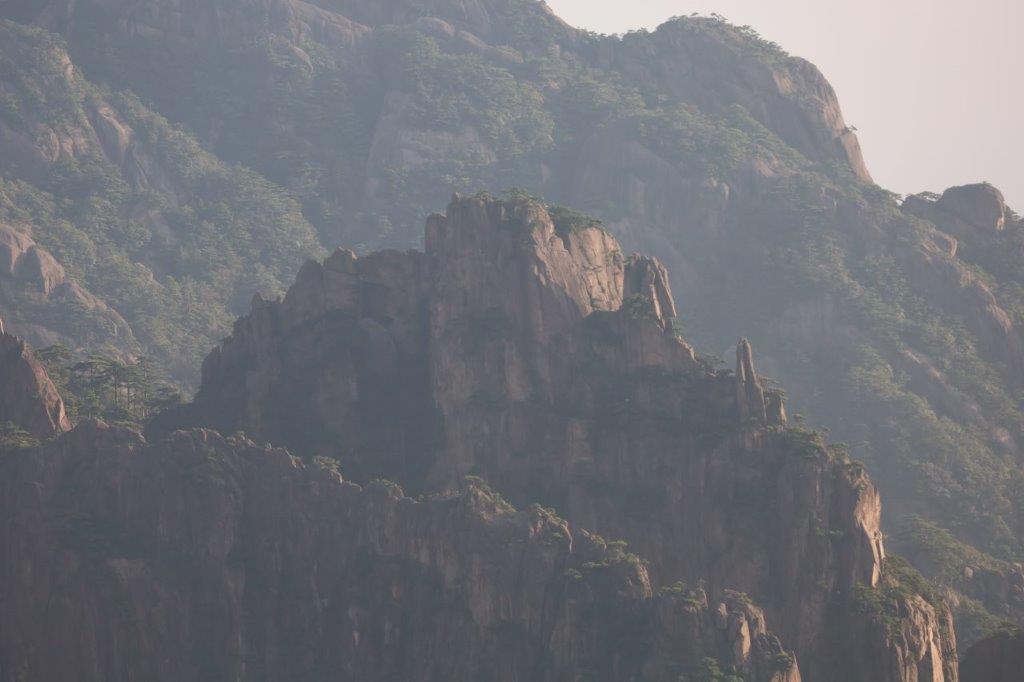 Beneath a boulder seemed to balance on top of a rock pillar …
Beneath a boulder seemed to balance on top of a rock pillar …
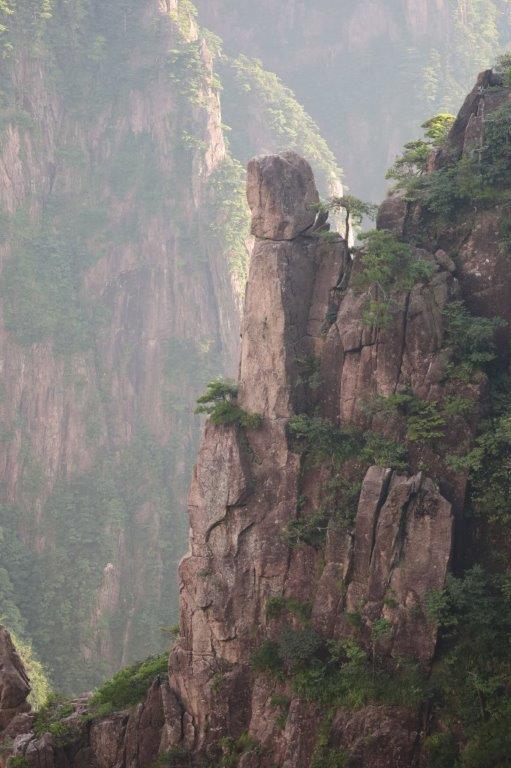 Again it was obvious why great movie directors had send their location scouts overhere to research for backdrops of their movies …
Again it was obvious why great movie directors had send their location scouts overhere to research for backdrops of their movies …
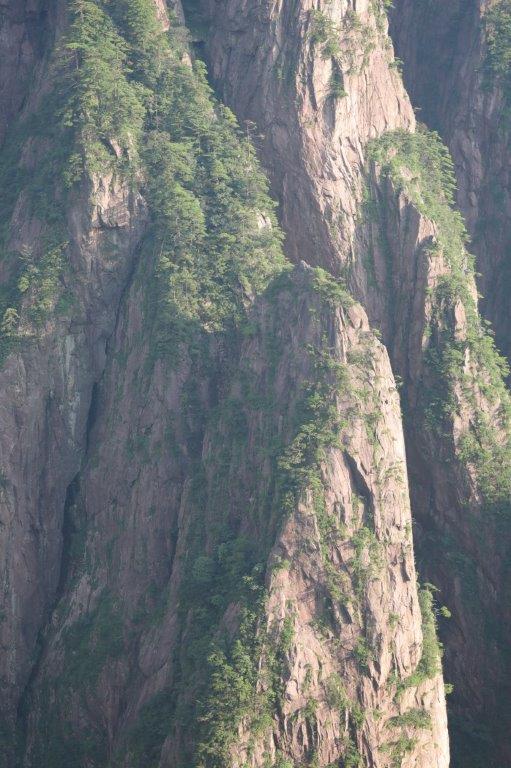 These impressive rock formations could be backdrops for historic drama’s, cheerful swashbuckling adventure movies with bandits, prehistoric landcapes where dinosaurs roamed or even unknown planets in a galaxy far far away. Everything, that could possibly be imagined in a cinematic way, seemed possible here …
These impressive rock formations could be backdrops for historic drama’s, cheerful swashbuckling adventure movies with bandits, prehistoric landcapes where dinosaurs roamed or even unknown planets in a galaxy far far away. Everything, that could possibly be imagined in a cinematic way, seemed possible here …
Although it was not possible to see the sun setting, it was more than breathtaking to see the fantastic landcape sink into a shroud of soft pastel like diffused colors …
The Wandelgek kept photographing and walking until he reached the point from where he and his guide Louise were about to returmn their steps …
 He had to return to the hotel before dark …
He had to return to the hotel before dark …
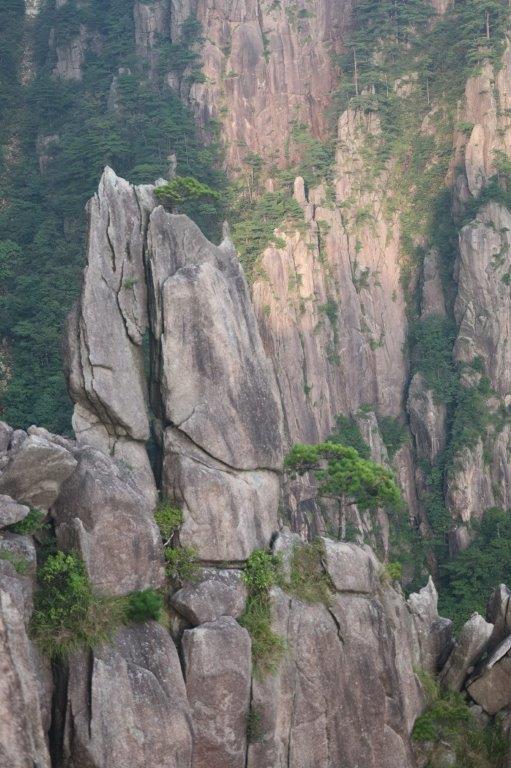 The Wandelgek stopped at a viewpoint from where he could see:
The Wandelgek stopped at a viewpoint from where he could see:
The Rock-Flying-from-Afar
The landscape was now covered in soft pastel colors and The Wandelgek could look up the mountains as far as the weather station …
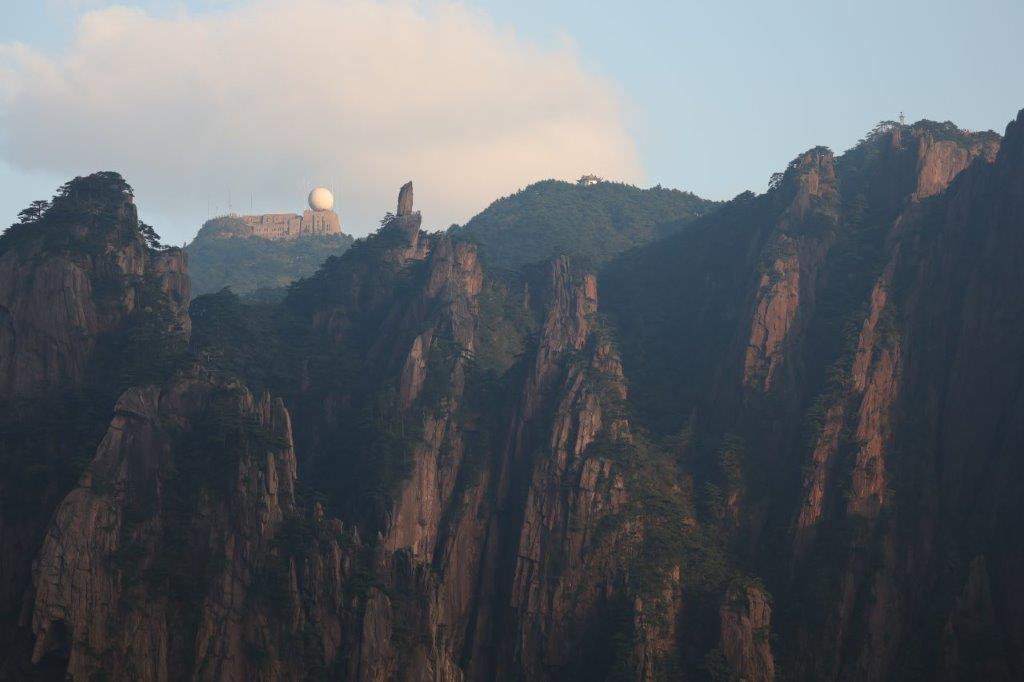 It was the best moment of the day …
It was the best moment of the day …
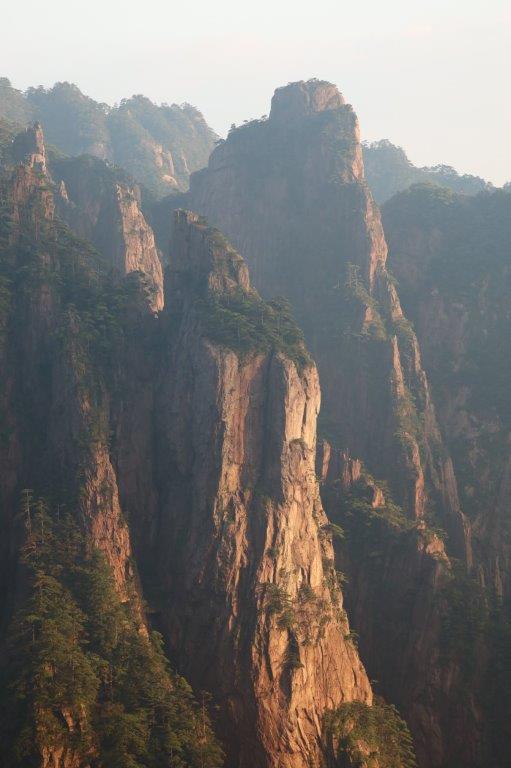 The silhouettes of the tree overgrown mountains got even better and most walkers had gone, either down the mountain or they were returning to their hotels which were spread over the mountain top.
The silhouettes of the tree overgrown mountains got even better and most walkers had gone, either down the mountain or they were returning to their hotels which were spread over the mountain top.
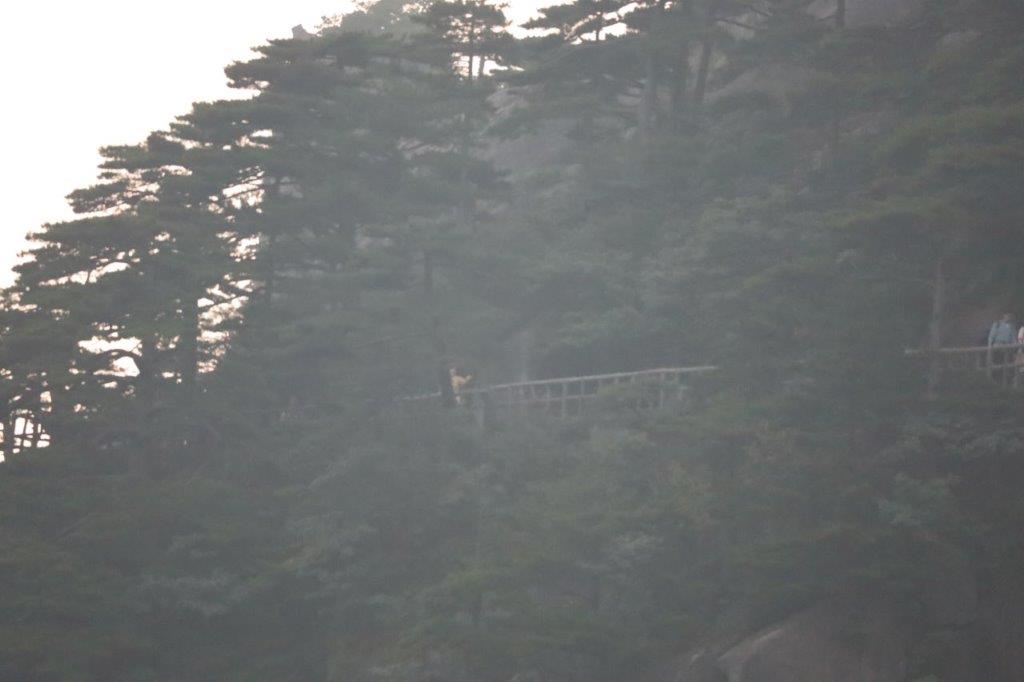 There were still some great shots to make …
There were still some great shots to make …
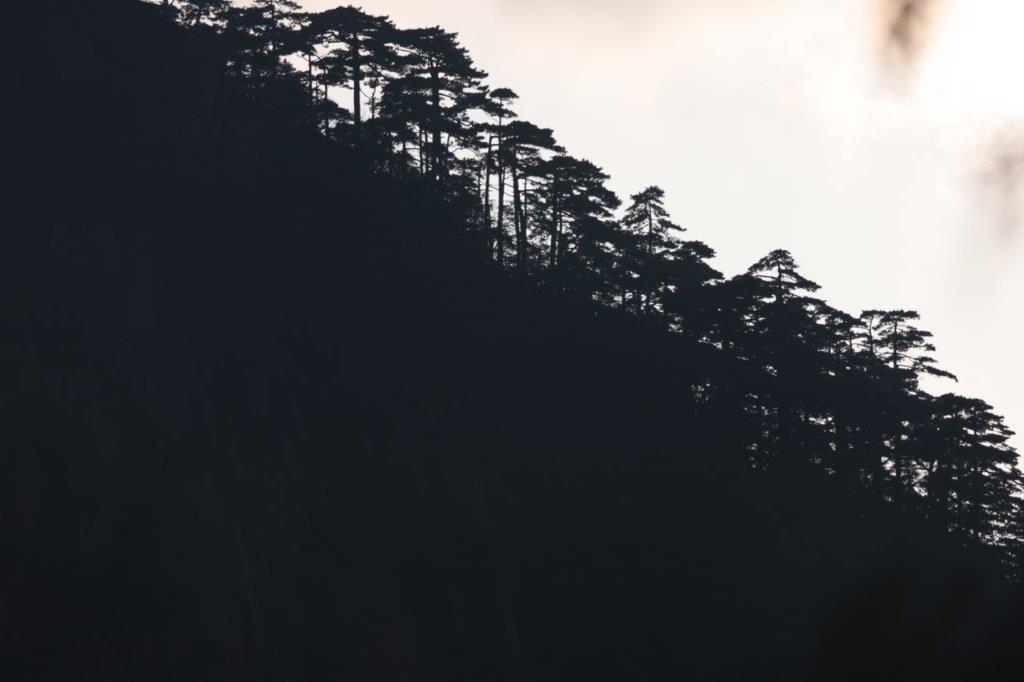 The light was subtle now and the mountains far away were slowly disappearing from view, but not quite yet …
The light was subtle now and the mountains far away were slowly disappearing from view, but not quite yet …
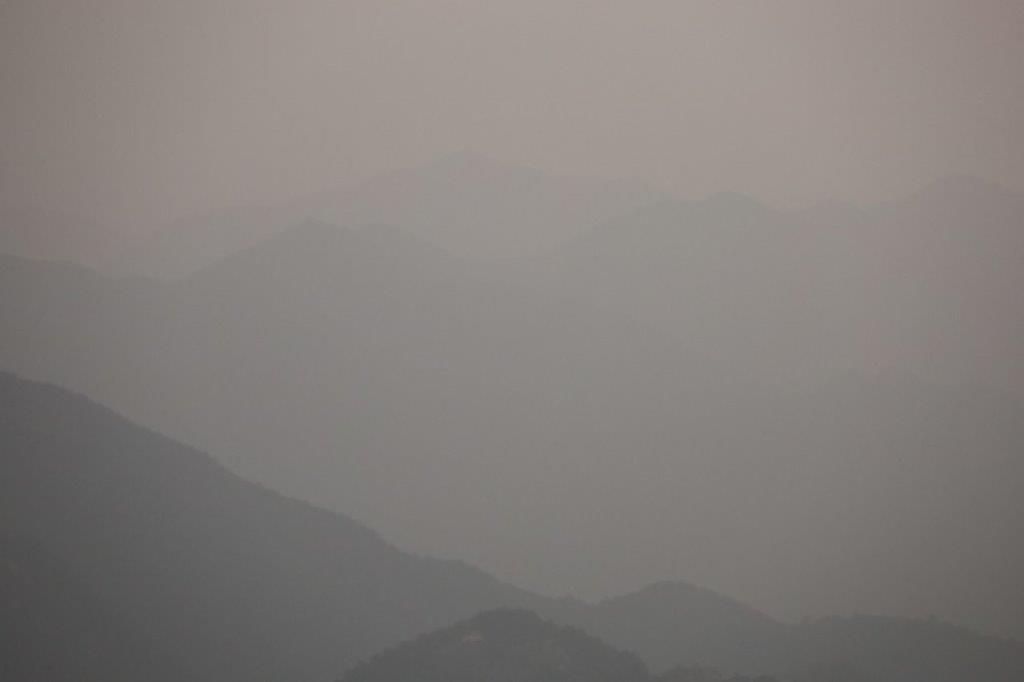 There was still time for enjoying some great views and for having a long rest and conversation, …
There was still time for enjoying some great views and for having a long rest and conversation, …
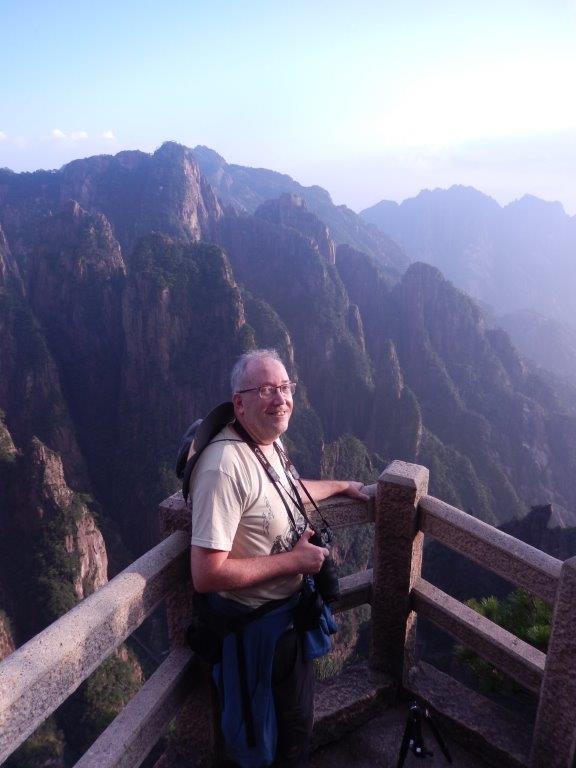 …but it was also time to finally return to the hotel and before he returned to his room, The Wandelgek invited his guide to drink a beer to celebrate the day.
…but it was also time to finally return to the hotel and before he returned to his room, The Wandelgek invited his guide to drink a beer to celebrate the day.
Having a nice pint of beer at the hotel bar
Luckily they had dark beer too 😀
It was also snack time and this snack was particularly strange. In Shanghai The Wandelgek had tried these Chinese Soy Beans sprinkled with black Truffle, but he did not like them at all (Yes to the truffle, but no to the beans), but now he had obtained a snack (a gift from Louise), which were dried, crispy Chinese Soy Beans sprinkled with garlic and these were fantastic as a snack.
 After this The Wandelgek returned to his room, to take a shower but he didn’t feel like resting or sleeping after that and returned to the bar for some more beers, a tea and snacks …
After this The Wandelgek returned to his room, to take a shower but he didn’t feel like resting or sleeping after that and returned to the bar for some more beers, a tea and snacks …
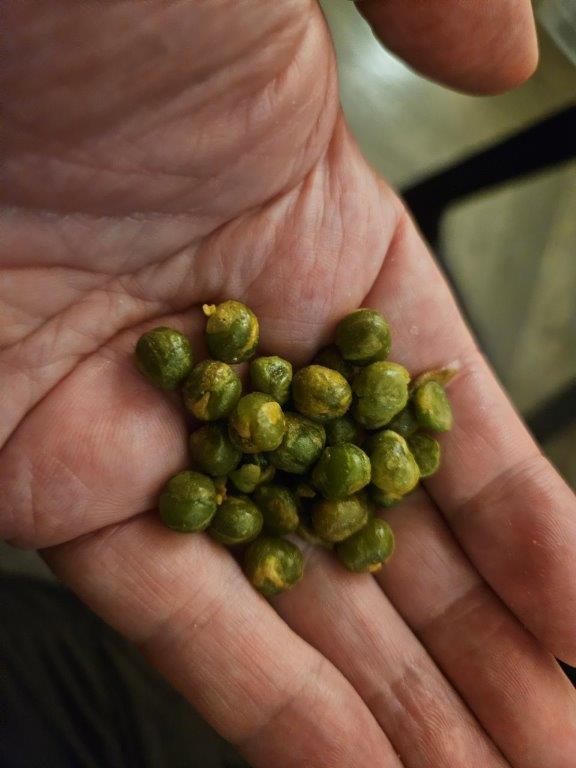 Then however it was time to return to the hotelroom and start sleeping, because the next morning was going to be an early one, which is somewhat of a pickle when being an evening person 😉
Then however it was time to return to the hotelroom and start sleeping, because the next morning was going to be an early one, which is somewhat of a pickle when being an evening person 😉

